Quake Global 96XXCS Q4000 / QPRO Satellite Module User Manual 1135 4713G GREEN Users Guide to Q4000 QPRO
Quake Global Inc. Q4000 / QPRO Satellite Module 1135 4713G GREEN Users Guide to Q4000 QPRO
Contents
Full Manual part 6
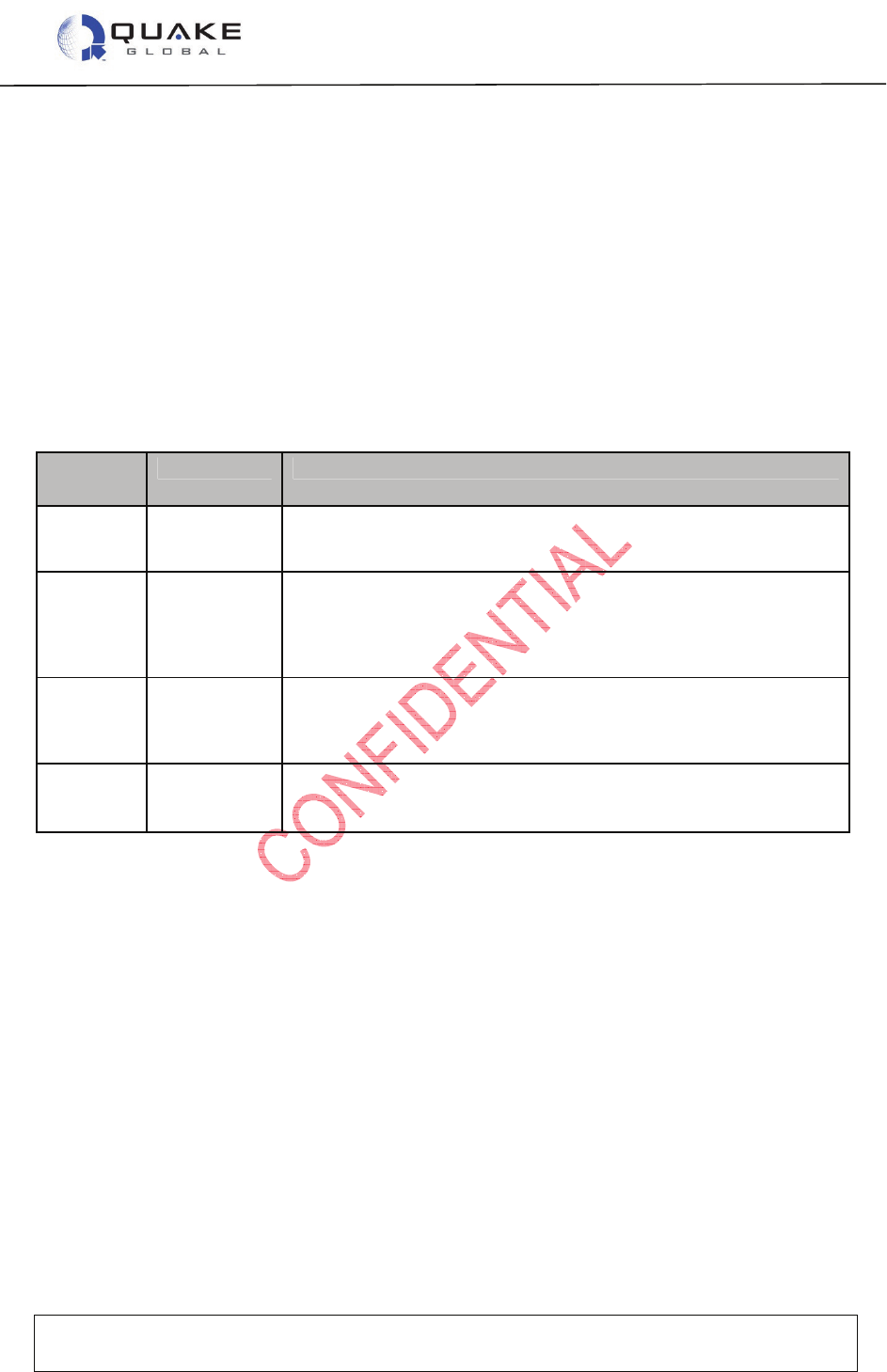
User Guide to Q4000/QPRO
Document Number 1135-4713 Rev G
THIS DOCUMENT CONTAINS CONFIDENTIAL AND PROPRIETARY INFORMATION OF QUAKE GLOBAL CORPORATION. IT MAY BE USED BY
RECIPIENT ONLY FOR THE PURPOSE FOR WHICH IT WAS TRANSMITTED AND WILL BE RETURNED UPON REQUEST OR WHEN NO LONGER NEEDED
BY RECIPIENT. DISCLOSURE TO UNAUTHORIZED THIRD PARTIES OR DUPLICATION WITHOUT THE EXPRESS WRITTEN PERMISSION OF QUAKE
GLOBAL IS PROHIBITED.
Page 140
CONFIDENTIAL
Information classified Confidential
-
Do not copy (See last page for obligations)
14.25 SPEED_ALARM
A GPS measurement completed and a speed violation occurred. The parameter [0-15] indicates
which Sensor Table was used.
14.26 TIMER
This occurs when a software timer expires. The parameter [0-39] indicates which timer expired.
Timers may be set, examined and read using function calls such as TIMER_set(),
TIMER_clear(), TIMER_checkWakeup(), TIMER_setDuration() and
TIMER_getRemaining(). Note that in making calls to the timer utilities, a particular timer must
be selected. It is important to select a timer with the appropriate type for the intended use. The
types and properties of all timers are shown in Table 14-1.
Table 14-1: Timer types and properties
Timer
Numbers
Timer Type
Description / Notes
0
-
9
Volatile
Value and status of these timers are lost when the modem powers
down. These timers should be used for general purpose timing
requirements. On power-up, all Volatile timers are set to disabled.
10
-
19
Non
-
Volatile
Value and status of these timers are stored in NVM. This type of timer is
used when timing data relating to an event or action must be maintained
during power off. When a Non-Volatile timer expires, it does not cause a
wake up of the modem, but does cause a timer event to be sent to the
application on the next power on.
20
-
29
Wake
-
Up
Wake-up timers are like nonvolatile timers, except that when a power
down is called, the Real-Time Clock (RTC) is programmed to wake up at
the timer expiration time (if this time is less than the specified power
down interval).
30
-
39
Time
-
Of
-
Day
These timers are identical to Wake-Up timers, except that the duration of
the timer is specified as an absolute time of day rather than relative to
the current time. Time-Of-Day Timers always expire within 24 hours.
14.27 TIME_SYNC
The time has been received from a source such as a satellite or GSM and the real-time clock has
been updated to the new time. Parameter one is the value of the change and should be
converted to a signed 32 value to ensure negative adjustments are accounted for.
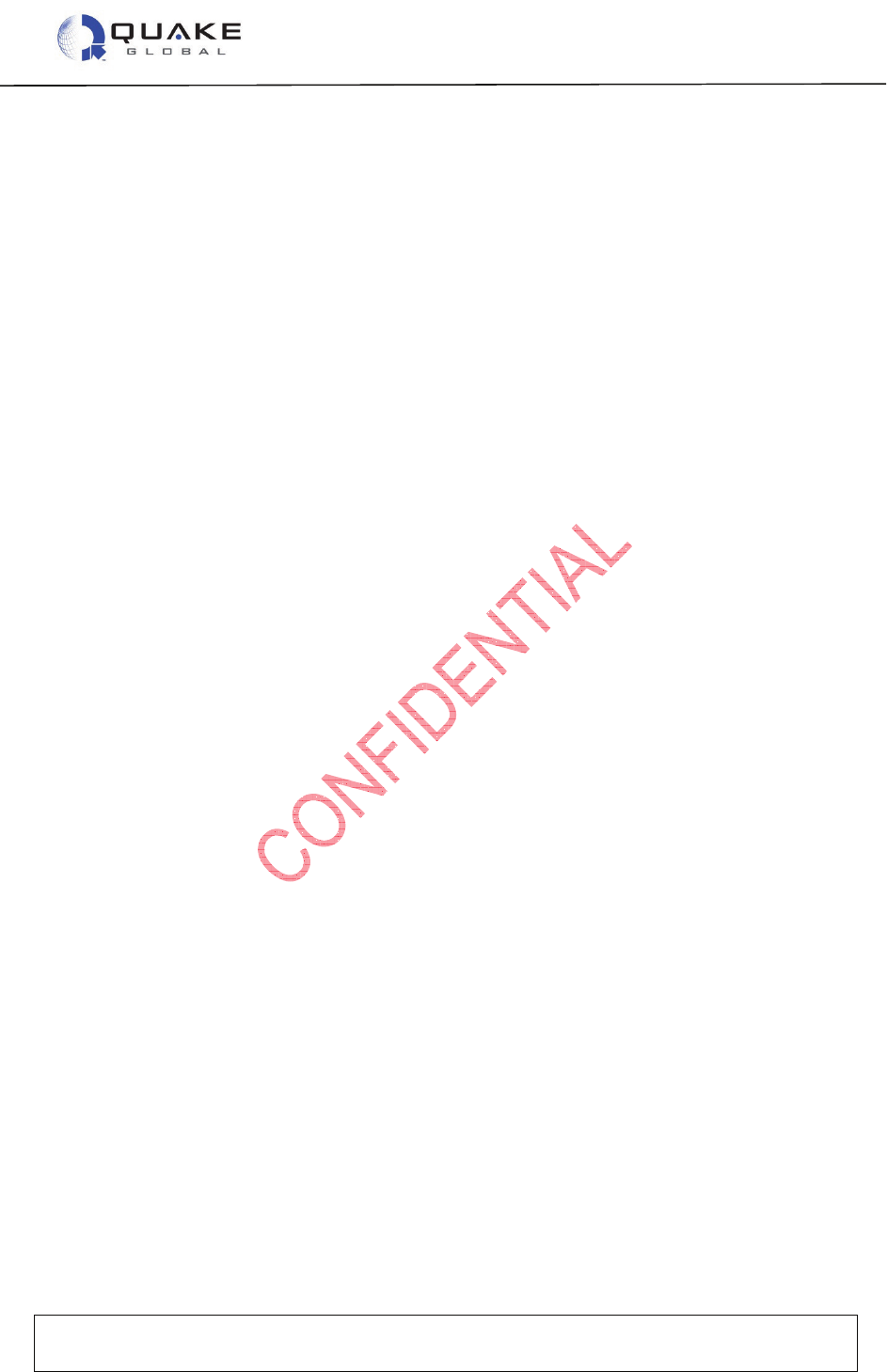
User Guide to Q4000/QPRO
Document Number 1135-4713 Rev G
THIS DOCUMENT CONTAINS CONFIDENTIAL AND PROPRIETARY INFORMATION OF QUAKE GLOBAL CORPORATION. IT MAY BE USED BY
RECIPIENT ONLY FOR THE PURPOSE FOR WHICH IT WAS TRANSMITTED AND WILL BE RETURNED UPON REQUEST OR WHEN NO LONGER NEEDED
BY RECIPIENT. DISCLOSURE TO UNAUTHORIZED THIRD PARTIES OR DUPLICATION WITHOUT THE EXPRESS WRITTEN PERMISSION OF QUAKE
GLOBAL IS PROHIBITED.
Page 141
CONFIDENTIAL
Information classified Confidential
-
Do not copy (See last page for obligations)
14.28 USER_CMD
An Over-The-Air command was received. The parameter [0-255] indicates which action to take.
This is currently supported for ORBCOMM and GSM/GPRS networks.
When a USER_CMD is sent, byte 0 of the data represents how many user commands will be
sent. This is based on User Data Bytes 1-4 content in conjunction with User Byte 0’s value.
For example, using:
USER DATA BYTES 0 1 2 3 4
Example. 1: If the data bytes sent were 0x01 0xFF 0x00 0x00 0x00
• One USER_CMD event would be sent to the application.
• It would be USER_CMD 255.
• Notice that User Data Bytes 2-4 have no meaning.
Example. 2: If the data bytes sent were 0x02 0xFF 0x00 0x00 0x00
• Two USER_CMD events would be sent to the application.
• They would be USER_CMD 255 and USER_CMD 0.
• In this case User Data Bytes 3 and 4 have no meaning.
Example. 3: If the data bytes sent were 0x03 0x01 0x02 0x03 0x00
• Three USER_CMD events would be sent to the application.
• They would be USER_CMD 0, USER_CMD 1 and USER_CMD 3.
• In this case User Byte 4 has no meaning.
Example. 4: If the data bytes sent were 0x04 0x01 0x02 0x03 0x0A
• Four USER_CMD events would be sent to the application.
• They would be USER_CMD 1, USER_CMD 2, USER_CMD 3, and USER_CMD 10.
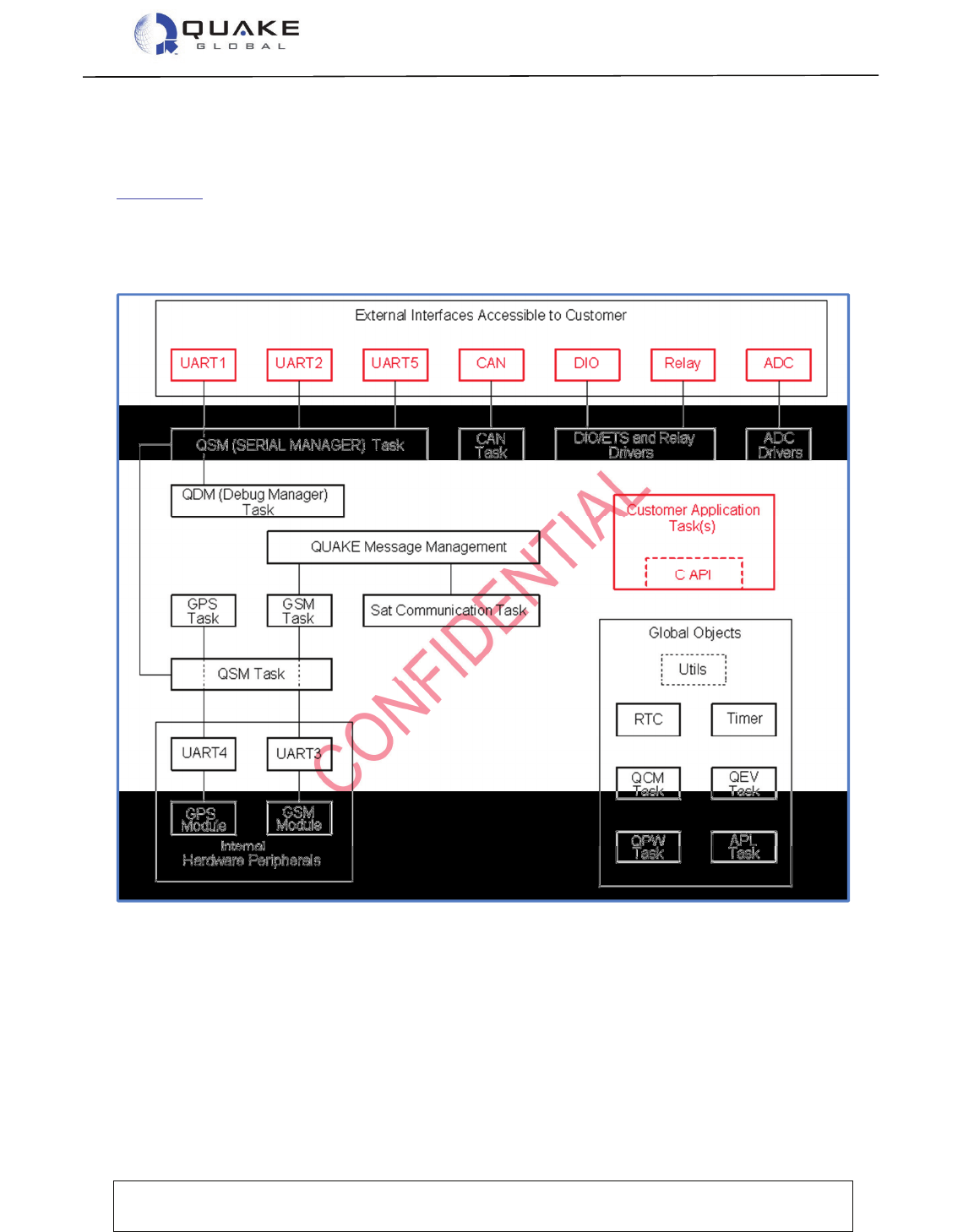
User Guide to Q4000/QPRO
Document Number 1135-4713 Rev G
THIS DOCUMENT CONTAINS CONFIDENTIAL AND PROPRIETARY INFORMATION OF QUAKE GLOBAL CORPORATION. IT MAY BE USED BY
RECIPIENT ONLY FOR THE PURPOSE FOR WHICH IT WAS TRANSMITTED AND WILL BE RETURNED UPON REQUEST OR WHEN NO LONGER NEEDED
BY RECIPIENT. DISCLOSURE TO UNAUTHORIZED THIRD PARTIES OR DUPLICATION WITHOUT THE EXPRESS WRITTEN PERMISSION OF QUAKE
GLOBAL IS PROHIBITED.
Page 142
CONFIDENTIAL
Information classified Confidential
-
Do not copy (See last page for obligations)
15 QUAKE firmware and APIs
Figure 15-1 shows the software architecture of the modem. The customer can write applications
that reside in the user space of the modem. The application makes use of the QUAKE
Application Programming Interface (API) to connect to the various tasks and drivers operating on
the modem. The custom application is either developed by the customer utilizing QUAKE’s API,
or by QUAKE’s engineering development services.
Figure 15-1: Software block diagram for fully loaded modem
The QUAKE foundation is statically linked as a single module. Only one customer module may
be dynamically linked to the foundation at a time. If a customer requires dynamically linked
modules in their application, they must design their own methods for linking in multiple objects.
Global variables are not linked between modules; however, customers may define and use their
own global variables. APIs must be explicitly declared by placing them in the function table and
the application cannot link to functions that are not provided in the API, even if they are in the
code. To add more functions, the user may build their own function table in memory and then
pass that address to other modules. That same mechanism can be used to create a ‘global
structure’ that contains all ‘global variables’ that can be passed to all modules.
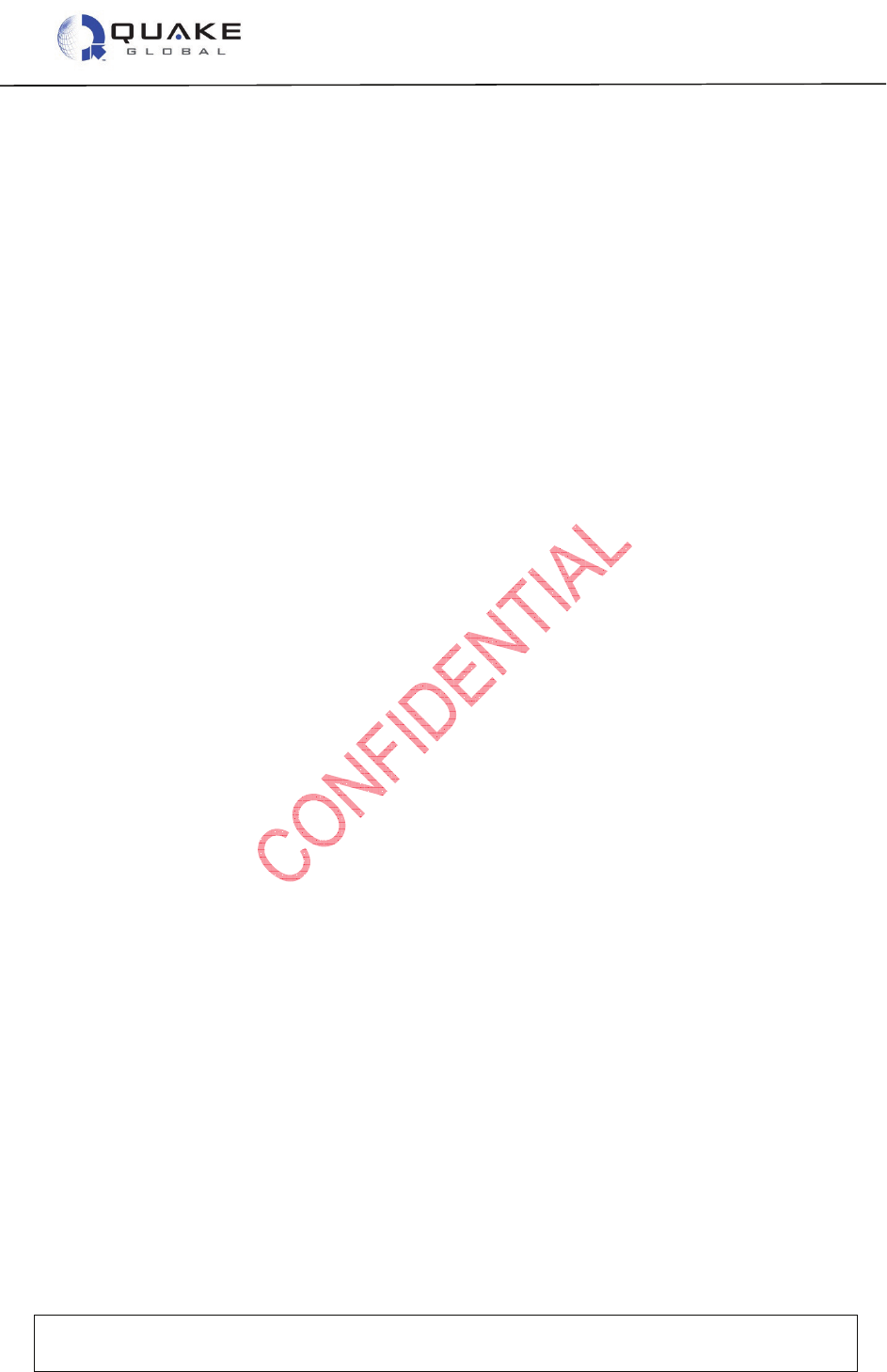
User Guide to Q4000/QPRO
Document Number 1135-4713 Rev G
THIS DOCUMENT CONTAINS CONFIDENTIAL AND PROPRIETARY INFORMATION OF QUAKE GLOBAL CORPORATION. IT MAY BE USED BY
RECIPIENT ONLY FOR THE PURPOSE FOR WHICH IT WAS TRANSMITTED AND WILL BE RETURNED UPON REQUEST OR WHEN NO LONGER NEEDED
BY RECIPIENT. DISCLOSURE TO UNAUTHORIZED THIRD PARTIES OR DUPLICATION WITHOUT THE EXPRESS WRITTEN PERMISSION OF QUAKE
GLOBAL IS PROHIBITED.
Page 143
CONFIDENTIAL
Information classified Confidential
-
Do not copy (See last page for obligations)
Please see the API Function Reference for detailed explanations on how to make function calls to
all the various tasks, drivers and objects operating on the modem.
QUAKE modems contain factory-installed foundation firmware that consists of the following
components:
• QUAKE Real-Time Operating System (RTOS)
• QUAKE Flash File System (FFS)
• Hardware drivers ( ADC, DIO, Relay, Serial Ports, GPS, etc.)
• QUAKE foundation software RTOS tasks
• Digital Signal Processing executables
• QUAKE code providing the event and application frameworks
It is not necessary to understand the operation of each of these modules in detail. The API
Function Reference provides the information that an application programmer is likely to need,
listing the functions available, information about the parameters and returns for the functions, as
well as additional notes and example code. A brief overview of the firmware modules, including
an overview of the module’s purpose and description of the more common calls, is provided
below.
15.1 ADC module (Analog to Digital Converter)
The ADC module provides access to the analog to digital converter hardware on the
Q4000/QPRO. The value of external analog inputs in the range 0 to 3.5 V applied to pins 29 and
31 of the external connector, may be read using the
ADC_readChannel()
function. As noted
in the API Function Reference,
ADC_readChannel()
should be called from a single task,
usually the application task.
15.2 APL module (Applications)
The APL module implements certain features which may be needed by specific applications. If
an application is designed to handle a specific AT command set, such as from an external
modem, APL_registerATCmdHandler() is used to register the handler for that device.
Messages specific to that type of AT command are sent to the application using the queue set up
by the function APL_msgQueueCreate(). Executables that an application needs to download
can be transferred into application memory via APL_loadObjects(). Other related APIs are
provided by the module described in the API Function Reference.
15.3 DIO module (Digital Input/Output)
There are 8 digital input/output lines on the Q4000/QPRO, accessed through pins 32-39. The
DIO module provides APIs to manipulate this hardware. Lines may be configured individually as
either inputs or outputs using the DIO_config(chan, direction) function, where the
second parameter may be either DIO_INPUT (0) or DIO_OUTPUT (1). All DIOs configured as
inputs have a weak pull-down resistor in the input circuitry, so an open is reliably sensed as low.
The 8 lines may be read as a group using DIO_readAll(). The nth bit in the value returned by
the call will be 1 or 0 when the nth channel is high or low, respectively. Lines configured as
outputs may be written by DIO_writeChannel().
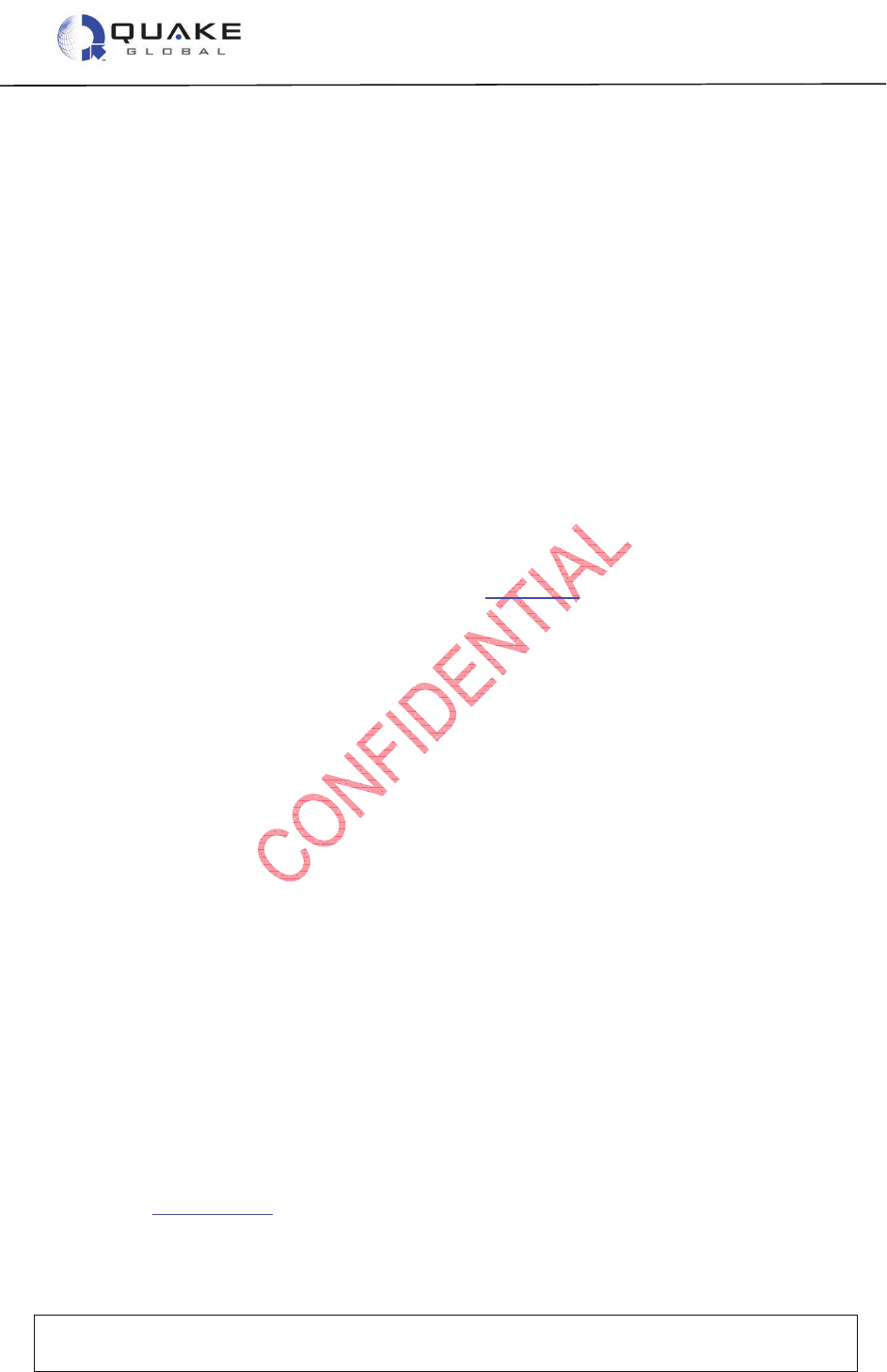
User Guide to Q4000/QPRO
Document Number 1135-4713 Rev G
THIS DOCUMENT CONTAINS CONFIDENTIAL AND PROPRIETARY INFORMATION OF QUAKE GLOBAL CORPORATION. IT MAY BE USED BY
RECIPIENT ONLY FOR THE PURPOSE FOR WHICH IT WAS TRANSMITTED AND WILL BE RETURNED UPON REQUEST OR WHEN NO LONGER NEEDED
BY RECIPIENT. DISCLOSURE TO UNAUTHORIZED THIRD PARTIES OR DUPLICATION WITHOUT THE EXPRESS WRITTEN PERMISSION OF QUAKE
GLOBAL IS PROHIBITED.
Page 144
CONFIDENTIAL
Information classified Confidential
-
Do not copy (See last page for obligations)
15.4 FFS module (Flash)
The Q4000/QPRO uses a FLASH File System (FFS). This FFS was designed specifically to be
robust and immune to problems encountered during uncontrolled power downs. FFS calls are
abstracted through a QUAKE FFS_ layer similar to the SYS layer, with calls such as
FFS_open(), FFS_read(), FFS_write(), FFS_close(). The application does not need
direct access to the FFS. However, the FFS_ calls are available if a custom application requires
them, and are intended to provide the same types of standard ‘C’ calls that are available for
accessing a UNIX file system
15.5 FTP module (File Transfer)
The FTP module implements the file transport protocol for transferring files, typically containing
large amounts of data, on terrestrial networks. Currently, FTP transfers are supported only on
the terrestrial network. The supported functions are described in the API Function Reference.
15.6 GPS module (Global Positioning System)
The GPS module supports finding the location, speed, heading, and altitude of the Q4000/QPRO
using the Global Positioning System. In addition, for Q4000/QPROs so equipped, the GPS is
used to obtain an accurate time to synchronize the real-time clock. Use of the GPS module is
demonstrated in the Turnkey sample application (see Section 2.6); however, the call to the key
GPS function GPS_read() is also made routinely in all the DemoAppXXX sample applications.
As seen in those examples, GPS_read() does everything needed to set up the GPS engine and
get a valid fix. When the fix is found, a POSITION_FIX event is posted to the application so that
the application can take appropriate action. Once a position fix has been made, the application
can retrieve the fix information using GPS_getPosData()to retrieve all the GPS information into
a structure of type GPS_Sample.
In addition, the GPS module provides a number of utility functions related to the GPS facility.
These are described in detail in the API Function Reference.
15.7 TERR module (Terrestrial)
The Terrestrial module supports communication over the terrestrial
GSM/GPRS/GSM/TCP/UDP/SMS networks. For sending a message from the application, the
module provides MSG_sendTerr(); for receiving a message, the application calls
MSG_receiveTerr(). Note also the event CELL_NET_IN_VIEW which provides information to
the application about the status of the cellular/GSM network and the fact that a MSG_ACK event is
posted when a GSM message has been successfully sent. The module provides a number of
additional utilities which may be useful in special circumstances which are described in the API
Function Reference.
15.8 ORBCOMM modules
OSI modules provide ORBCOMM support. The OSI module implements code to support the
ORBCOMM Serial Interface and related features. It is available on Q4000/QPROs with the
ORBCOMM satellite transceiver. The OSI is described in the ORBCOMM Serial Interface
Specification. A typical use of the module and transceiver is shown in the DemoAppGSM sample
application in Section 12.4.1.
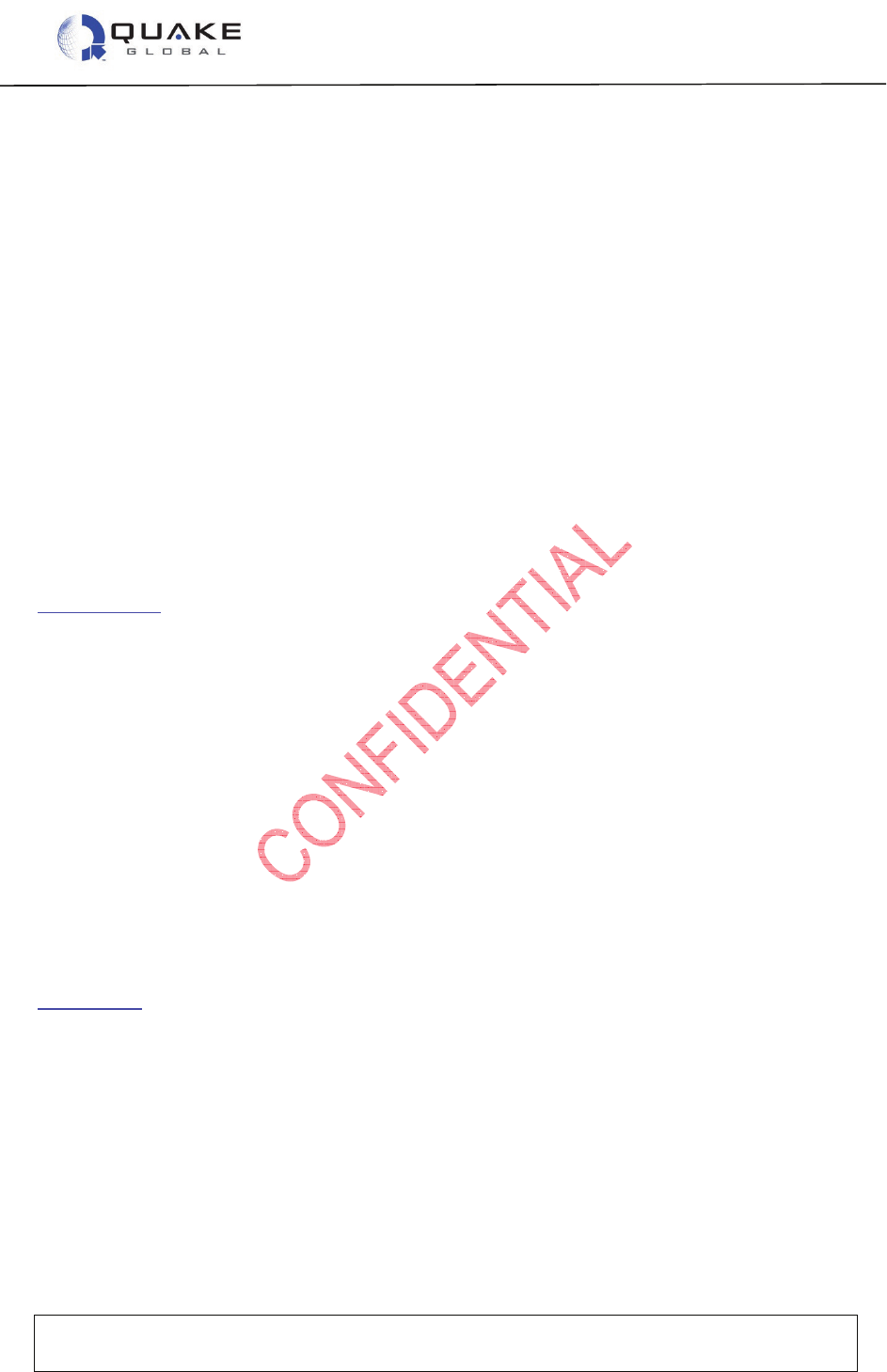
User Guide to Q4000/QPRO
Document Number 1135-4713 Rev G
THIS DOCUMENT CONTAINS CONFIDENTIAL AND PROPRIETARY INFORMATION OF QUAKE GLOBAL CORPORATION. IT MAY BE USED BY
RECIPIENT ONLY FOR THE PURPOSE FOR WHICH IT WAS TRANSMITTED AND WILL BE RETURNED UPON REQUEST OR WHEN NO LONGER NEEDED
BY RECIPIENT. DISCLOSURE TO UNAUTHORIZED THIRD PARTIES OR DUPLICATION WITHOUT THE EXPRESS WRITTEN PERMISSION OF QUAKE
GLOBAL IS PROHIBITED.
Page 145
CONFIDENTIAL
Information classified Confidential
-
Do not copy (See last page for obligations)
An ORBCOMM packet is constructed specifying a particular type of ORBCOMM message, based
on packet descriptions in the ORBCOMM Serial Interface Specification. The packet is queued to
the OSI using
MSG_queueOsiPkt()
. The module contains utilities as well as functions to
read and write ORBCOMM parameters (
CFG_getValOrb()
and
CFG_setValOrb()
). The
QUAKE event structure provides the application easy access to much of the ORBCOMM
functionality; for example, in the
SAT_IN_VIEW, MESSAGE_ACK
, and
RX_SER_PKT
cases,
which are executed when the corresponding event is posted. A message received by the
Q4000/QPRO is handled by the application in the appropriate sub-case of the
RX_SER_PKT
case.
15.9 J1939 module (Controller Area Network - CAN)
The J1939 module supports use of the Controller Area Network (CAN) hardware, and the
protocols using CAN. Currently, J1939 is the only CAN protocol supported. Most calls to setup
and configure the CAN hardware and J1939 stack are handled automatically by the foundation
code. Typically, an application would request a J1939 message containing a particular
Parameter Group Number (PGN) using the call
J1939_getPgnMsg()
.
The structure for a QCAN_J1939Msg can be found in
User_libQuake.h
. The offsets for
various SPNs (Suspect Parameter Numbers) in the message data buffer are specified by the
Society of Automotive Engineers (SAE), and described in their document, J1939-71. In the
DemoAppCAN example, the application requests and receives a specific PGN and SPN from the
message. The application structure is set to field a
CAN_MSG
event, in the corresponding
CAN_MSG
case. In the rare case in which a desired PGN is not spontaneously transmitted on the
bus, an request for that PGN must be transmitted, using the API call
J1939_txRequestMsg()
.
15.10 QCFG module (Configuration)
The QCFG module provides an interface to manipulate QUAKE’s configuration parameters. The
current set of QUAKE parameters may be viewed from the Logger port of the Q4000/QPRO; in
the Logger type ‘U’ ‘C’ ‘v’. Parameters may be numeric or strings. The API call to this module is
QCfg_getQCfgPtr(
), which returns a pointer to the configuration structure.
15.11 QEV module (Events)
The QEV module implements functions related to QUAKE’s event processing. The application
relies on the event processing supported in the foundation code, by executing code when specific
events are posted to the application. This activity can be seen in all of the DemoApps in
Section 12.4. In addition, the application may post an event by calling
QEV_sendEvent()
.
The public APIs in this module also provide the utility,
QEV_getEventDefinition()
, which
returns a pointer to the name of the event whose number is passed as a parameter.
15.12 QLM module (Logger)
The Logger port of the QUAKE modems provides a wealth of information and functionality.
Typically, messages about modem status such as downlink information, state transitions, or error
messages are printed to the Logger port. Debug and Utility menus and features are accessed
from the Logger port. The QLM module’s public APIs allow the application to post messages to
the Logger using
LOG_print()
or to suspend Logger output entirely using
LOG_suspend()
.
The function,
LOG_logErrorMsg()
provides a way to print error messages to the Logger,
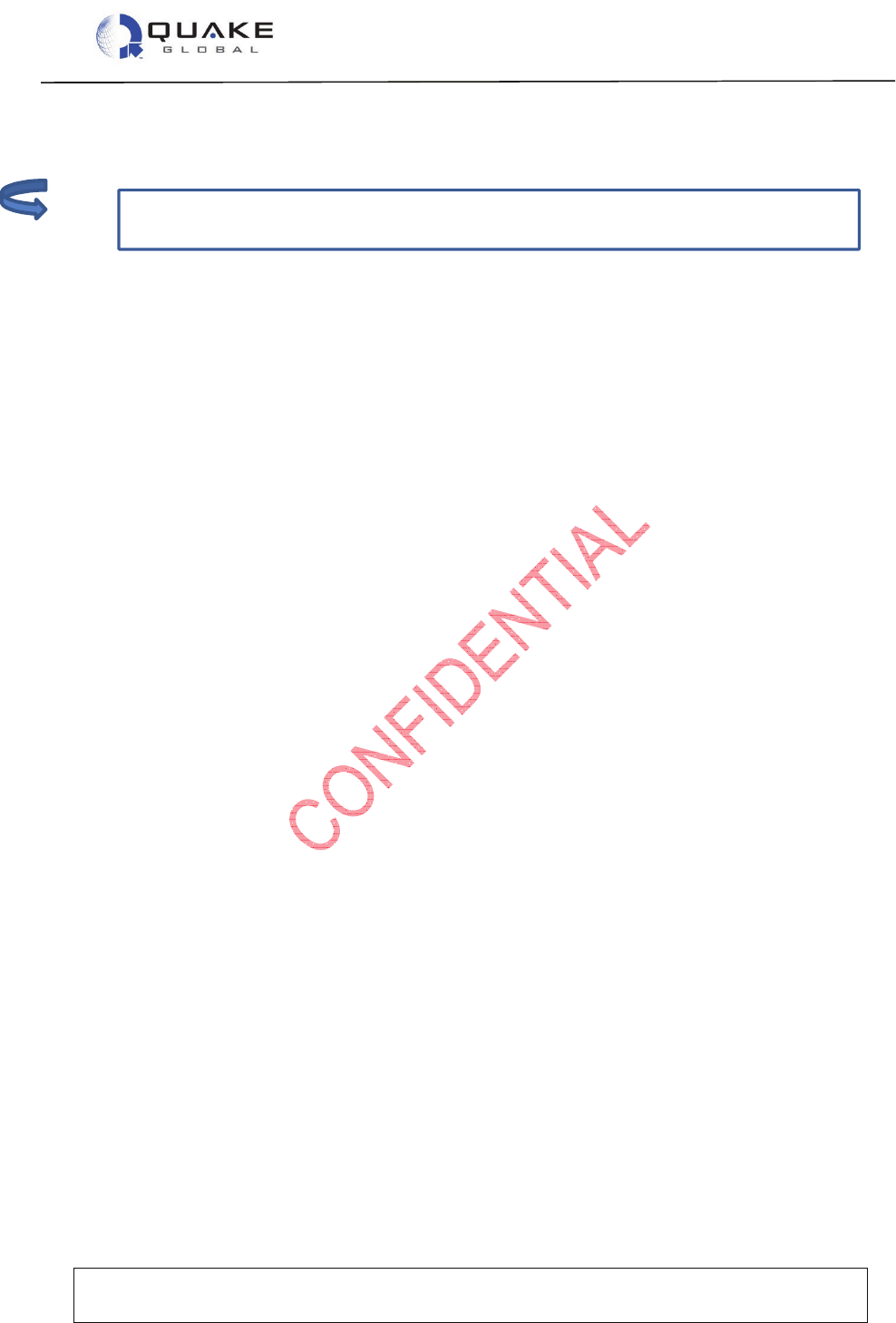
User Guide to Q4000/QPRO
Document Number 1135-4713 Rev G
THIS DOCUMENT CONTAINS CONFIDENTIAL AND PROPRIETARY INFORMATION OF QUAKE GLOBAL CORPORATION. IT MAY BE USED BY
RECIPIENT ONLY FOR THE PURPOSE FOR WHICH IT WAS TRANSMITTED AND WILL BE RETURNED UPON REQUEST OR WHEN NO LONGER NEEDED
BY RECIPIENT. DISCLOSURE TO UNAUTHORIZED THIRD PARTIES OR DUPLICATION WITHOUT THE EXPRESS WRITTEN PERMISSION OF QUAKE
GLOBAL IS PROHIBITED.
Page 146
CONFIDENTIAL
Information classified Confidential
-
Do not copy (See last page for obligations)
The message packet should not be freed by the application; this is done by the
foundation code.
complete with the name of the function in which the error occurred, the line number, and a string
identifying the type of error.
15.13 QMM module (Messages)
The QMM module implements QUAKE’s Message Manager. The firmware code in the module
checks for network availability, and handles the details of transferring messages from one
network to another based on availability. This is all transparent to the application. The primary
public API implemented in this module is
MSG_send()
; this and other APIs for actions such as
deleting messages and getting a current message count are described in the API Function
Reference.
15.14 SYS module (System)
On the Q4000/QPRO, the Real-Time Operating System (RTOS) is abstracted to QUAKE calls so
that regardless of any changes to the underlying RTOS calls, the APIs available on QUAKE
modems remain constant. This abstraction is performed by the SYS module. Functionality to
manage tasks and message queues is provided with names like
SYS_taskCreate()
or
SYS_taskSuspend()
which clearly indicate the functionality to any application developer
familiar with using an RTOS on an embedded target. For most applications, no direct calls to the
SYS module need to be made since the foundation code and the event driven architecture allow
complex applications to be developed without direct calls to the RTOS. For those applications
that need direct RTOS access, however, it is provided by the SYS module.
SYS_pwrDown()
is used to power down the Q4000/QPRO in a controlled fashion. Everything
is shut off cleanly in the correct order, ensuring that on a subsequent reboot no data will have
been lost and the Q4000/QPRO is in an appropriate state.
15.15 SERIAL module
Access to the serial ports is provided by the QUAKE Serial Manager module. One goal in
developing SERIAL was to provide a high-level serial interface that allows different tasks, such as
OSI, QCT, or an AT protocol, that are managing different serial protocols, to share a single
physical serial port. These sorts of activities are handled by the foundation and should not be
needed by the application. Calls to
SERIAL_readBytes()
and
SERIAL_write()
allow
the application to read and write to the serial ports. The
UARTPORTS
are enumerated in
User_libQuake.h.
SERIAL_openPort
and
SERIAL_closePort
are provided, as well as
SERIAL_portFlush
, and are described in the API Function Reference.
15.16 RELAY module
The RELAY module provides access to the relay hardware on the Q4000/QPRO. Four relay lines
are implemented. Two of them, UBATT0 and UBATT1, when asserted, provide closure to the
supply voltage at pins 25 and 27, respectively. The other two, GND0 and GND1, when asserted,
provide closure to ground at pins 26 and 28. The
RELAY_CHAN_NAME
type is enumerated in
User_libQuake.h. The RELAY module APIs allow the application to read the state of the lines or
assert or deassert the lines by individual channel number.
Note:
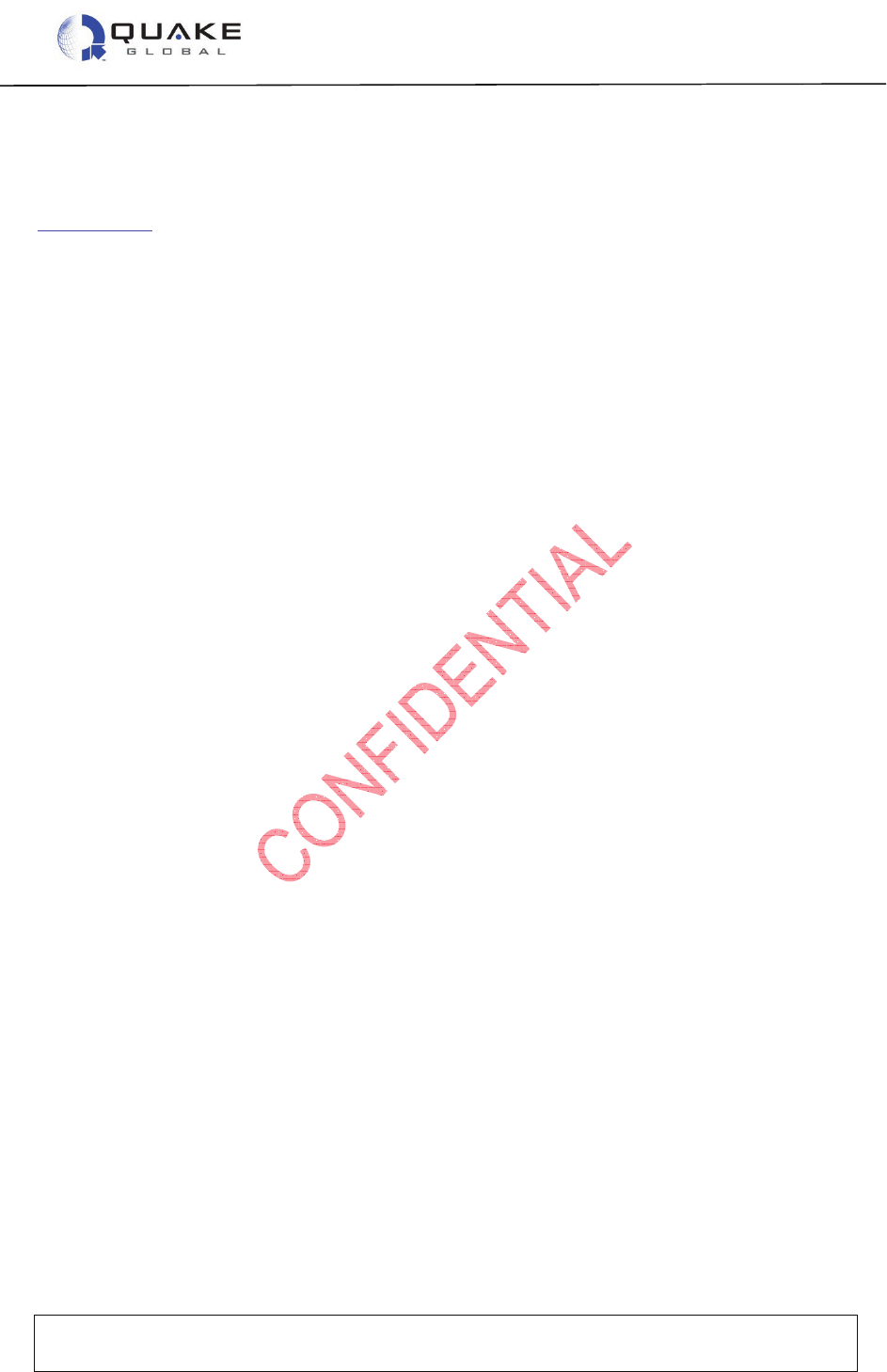
User Guide to Q4000/QPRO
Document Number 1135-4713 Rev G
THIS DOCUMENT CONTAINS CONFIDENTIAL AND PROPRIETARY INFORMATION OF QUAKE GLOBAL CORPORATION. IT MAY BE USED BY
RECIPIENT ONLY FOR THE PURPOSE FOR WHICH IT WAS TRANSMITTED AND WILL BE RETURNED UPON REQUEST OR WHEN NO LONGER NEEDED
BY RECIPIENT. DISCLOSURE TO UNAUTHORIZED THIRD PARTIES OR DUPLICATION WITHOUT THE EXPRESS WRITTEN PERMISSION OF QUAKE
GLOBAL IS PROHIBITED.
Page 147
CONFIDENTIAL
Information classified Confidential
-
Do not copy (See last page for obligations)
15.17 UART module
The UART module provides direct access to the serial hardware on the Q4000/QPRO.
Application access to the serial ports should be made through the SERIAL module, described in
Section 15.15. SERIAL allows the foundation firmware to exercise more control and oversight.
For those applications requiring more direct access, the public API to the UART module is
UART_ioctl()
, which allows the parity, stop bits and baud rate to be set for serial ports.
15.18 UTL module (Utilities)
The UTL module proves a number of utility functions. Some allow manipulation of the QUAKE
software counters and timers, such as
CNTR_set()
, and
CNTR_read()
or the system’s real-
time clock, such as
SYS_readSeconds()
. The API Function Reference should be consulted
for a current list with complete descriptions.
15.19 VSWR module (Voltage Standing Wave Ratio)
The single public API in the VSWR module is
ANT_readVswrOrb()
. This reports the last
VSWR reading of the ORBCOMM antenna. Notes in the API Function Reference give details on
interpreting the reading.
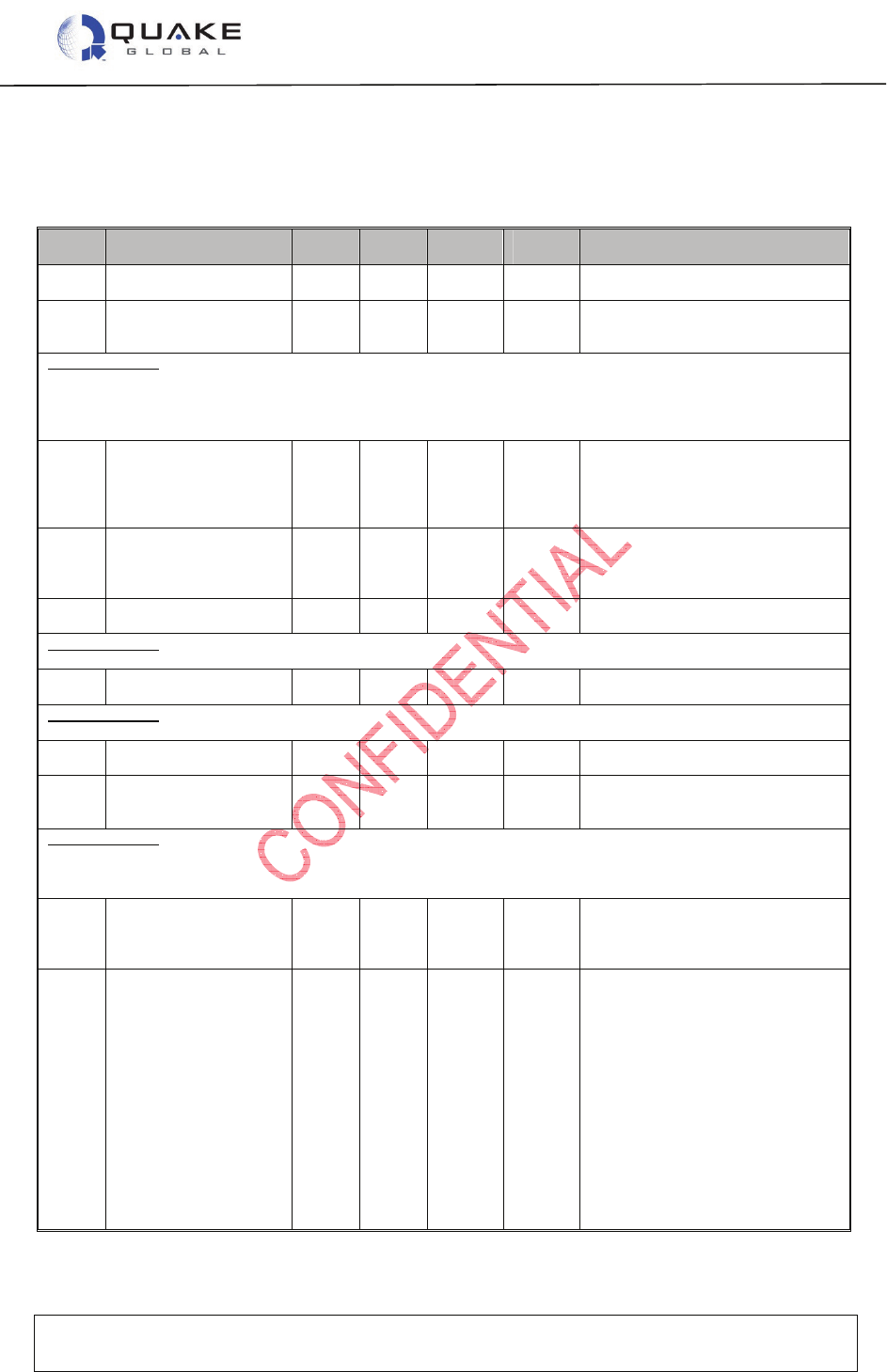
User Guide to Q4000/QPRO
Document Number 1135-4713 Rev G
THIS DOCUMENT CONTAINS CONFIDENTIAL AND PROPRIETARY INFORMATION OF QUAKE GLOBAL CORPORATION. IT MAY BE USED BY
RECIPIENT ONLY FOR THE PURPOSE FOR WHICH IT WAS TRANSMITTED AND WILL BE RETURNED UPON REQUEST OR WHEN NO LONGER NEEDED
BY RECIPIENT. DISCLOSURE TO UNAUTHORIZED THIRD PARTIES OR DUPLICATION WITHOUT THE EXPRESS WRITTEN PERMISSION OF QUAKE
GLOBAL IS PROHIBITED.
Page 148
CONFIDENTIAL
Information classified Confidential
-
Do not copy (See last page for obligations)
Appendix A - ORBCOMM configuration parameters
Table A-1: ORBCOMM configuration parameters
Num Name
Def.
Value
Min
Value
Max
Value
DTE
Access Description
0x00 pin_code 1234 0 9999 R/W Personal Identification Number, used
as a security measure
0x01 desired_gwy_id
1 (U.S.)
0 255 R/W
Instructs modem to acquire satellite
connected to this ORBCOMM
Gateway
Additional notes: This parameter should be set according to where the application/modem will be located. If the
modem is only used in North or South America this parameter should be set to 1. If the application/modem is located
in Japan, it should be 130. The rest of the world should be set to 120. For mobile applications that are not specific not
one area please consider use of the Auto-roaming feature (parameter 0x8b). More information on this feature may be
found below.
0x02 def_polled 0 0 1 R/W
Modem-Originated messages polled
by ORBCOMM Gateway or initiated
by modem (see OSI Section 3.2,
note 1). Type Codes 1, 4, and 5 are
supported.
0x03 def_ack_level 2 0 4 R/W
Default acknowledgement level for
messages (see OSI Section 3.2 note
3). Note: Values other than 2 are not
recommended.
0x04 def_rep_or_ind 1 0 3 R/W Default Report O/R Indicator (see
OSI Section 3.2, note 4)
Additional notes: This parameter is used for setting the O/R indicator that will be associated with the ‘Default Report’
message type. All Default Reports will be routed to the specified O/R indicator.
0x05 def_msg_or_ind 1 0 15 R/W Default Message O/R Indicator (see
OSI Section 3.2, note 4)
Additional notes: This parameter is used for setting the O/R indicator that will be associated with the ‘Default Message’
message type. All Default Messages will be routed to the specified O/R indicator.
0x06 def_priority 1 0 3 R/W Default Priority Level (see OSI
Section 3.2 note 5)
0x07 def_msg_body_type 14 0 15 R/W
Default Priority Level (see OSI
Section 3.2 note 6). Note: Only
values 0 and 14 are supported.
Additional notes: This parameter primarily comes into play when using email as a delivery method for modem-O
messages. The only two supported modes are 0 (data will be received in the form of AmodemII text within the email
message body) or 14 (data will be received as a binary data attachment to the email). If using direct IP a setting of 14
should be used.
0x08 def_serv_type 2 0 15 R/W
Default Service Type for reports (see
OSI Section 3.2 note 2). Note:
Values other than 2 are not
recommended.
0x09 gwy_search_mode 0 0 4 R/W
0=continuously search downlink band
for desired GWY; 1=search band
once for desired GWY, if not found
then maintain lock with first
discovered downlink; 2=maintain lock
with first discovered downlink;
3=search band once for desired
GWY, if found, open search to
include any ORBCOMM GWY, if
none found, maintain lock with first
discovered downlink; 4=search band
once for desired GWY, if not found,
continuously search band for
downlink having no ORBCOMM
Gateway or desired GWY
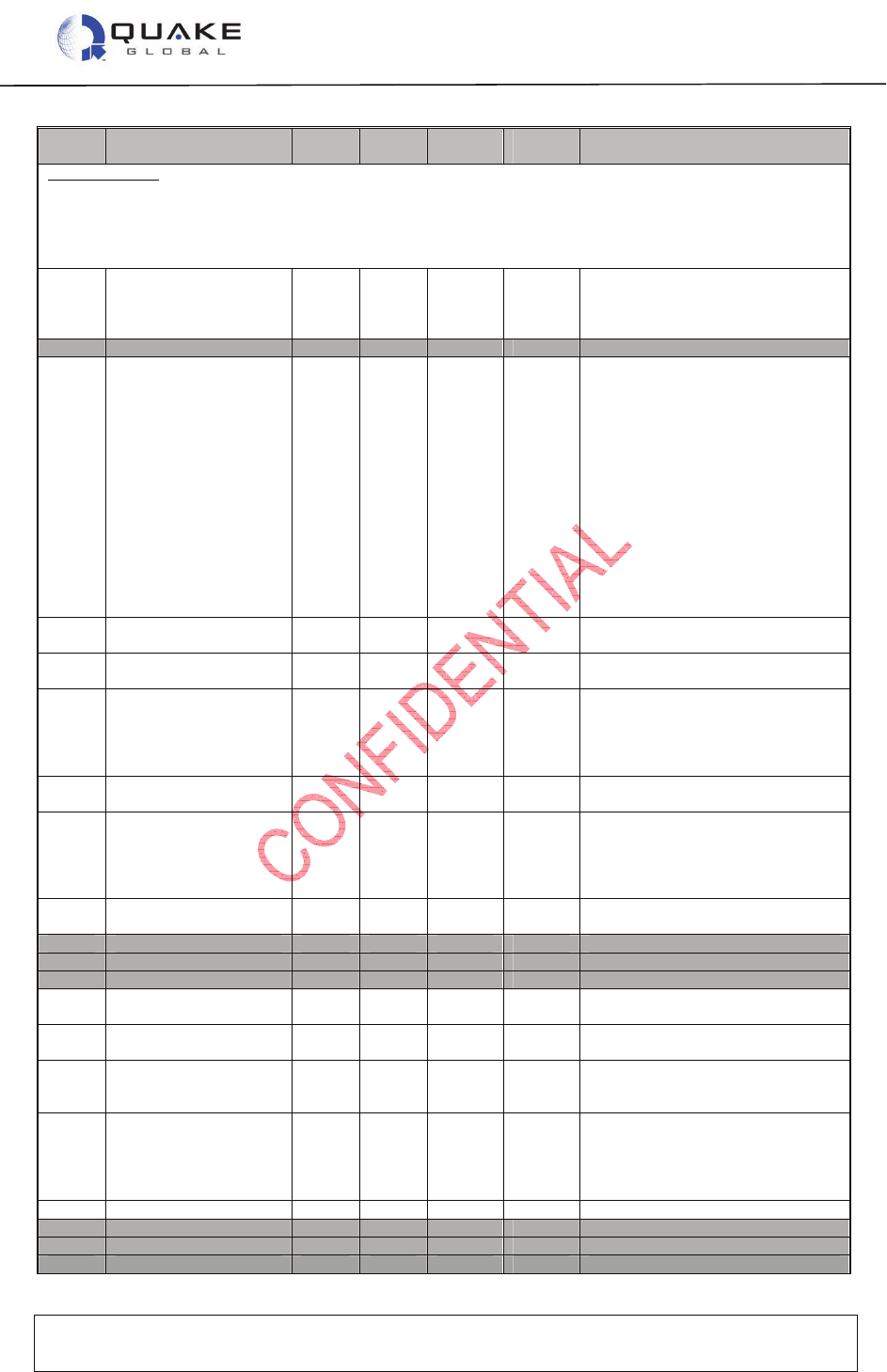
User Guide to Q4000/QPRO
Document Number 1135-4713 Rev G
THIS DOCUMENT CONTAINS CONFIDENTIAL AND PROPRIETARY INFORMATION OF QUAKE GLOBAL CORPORATION. IT MAY BE USED BY
RECIPIENT ONLY FOR THE PURPOSE FOR WHICH IT WAS TRANSMITTED AND WILL BE RETURNED UPON REQUEST OR WHEN NO LONGER NEEDED
BY RECIPIENT. DISCLOSURE TO UNAUTHORIZED THIRD PARTIES OR DUPLICATION WITHOUT THE EXPRESS WRITTEN PERMISSION OF QUAKE
GLOBAL IS PROHIBITED.
Page 149
CONFIDENTIAL
Information classified Confidential
-
Do not copy (See last page for obligations)
Num Name
Def.
Value
Min
Value
Max
Value
DTE
Access Description
Additional notes: This parameter defines the way in which the modem will connect to satellites as they come into view.
It works in conjunction with parameter 0x01 (desired_gwy_id). By default the modem will only connect to satellites that
are attached to the desired gateway. If using global grams a setting of 3 or 4 is recommended so that the modem can
connect with satellites that are not attached to a gateway (this condition is required to send a global gram). Using a
setting of 3 or 4 in conjunction with Auto Roaming (0x8b) enabled will allow the modem to connect and send messages
to different gateways automatically (see Auto Roaming description for more information).
0x0a ob_route 2 0 2 R/W
Route outbound messages/
commands to: 0=local application
task; 1=serial port; 2=both. This
value should be 0 for QCP.
0x0b inactive_interval 0 0 86400 R/W NOT SUPPORTED
0x0c sc_state 0 0 10 R
State of modem message transport
processes: 0=Idle; 1=Sending
modem-Originated message;
2=Sending modem-Originated report;
3=Sending modem-Originated
Globalgram; 4=Receiving modem-
Terminated message; 5=Receiving
modem-Terminated command;
6=Receiving modem-Terminated
Global Gram; 7=Performing self-test;
8=Performing local loop-back;
9=performing ORBCOMM Gateway
loop-back test (may require a minute
or two, depending on Satellite
availability)
0x0d sc_diag_code 0 --- --- R modem Diagnostics Result Code
(See OSI Section 3.2 note 9)
0x0e active_mha_ref_num 0 0 255 R Active MHA Message Reference
number (255 = no messages)
0x0f sat_in_view 0 0 255 R
Number of Current Satellite in View
(0 if no satellite in view). Note:
Currently this parameter returns only
0 or 1 (0=no satellite in view,
1=satellite in view)
0x10 gwy_id_list --- --- --- R List of IDs of ORBCOMM Gateways
connected to the current satellite
0x11 min_gwy_pri_list --- --- --- R
List of minimum acceptable message
priorities for each Gateway identified
in parameter 0x10, in the same order
as the Gateways identified in
param0x10
Numb
er Name
Def.
Value
Min
Value
Max
Value
DTE
Access Description
0x12 msg_queue_size --- --- --- R NOT SUPPORTED
0x13 sco_msg_queue_size --- --- --- R/W NOT SUPPORTED
0x14 sct_msg_queue_size --- --- --- R/W NOT SUPPORTED
0x15 queue_ob_msgs --- --- --- R Number of modem-Terminated
messages in queue
0x16 queue_ib_msgs --- 0 --- R Number of modem-Originated
messages in queue
0x17 week_bytes --- 0 --- R/W
UTC time week (0 = week starting
Sunday January 6, 1980 00:00:00
UTC)
0x18 time_bytes --- 0 604799 R/W
24-bit integer representing the
number of seconds since 00:00:00
UTC of the previous Sunday (resets
12:00 A.M. Saturday night / Sunday
morning)
0x19 total_sats --- --- --- R Total number of satellites in system
0x1a stored_sats 0 0 --- R NOT SUPPORTED
0x1b pos_calc_active 1 0 1 R/W NOT SUPPORTED
0x1c pos_age --- 0 65535 R NOT SUPPORTED
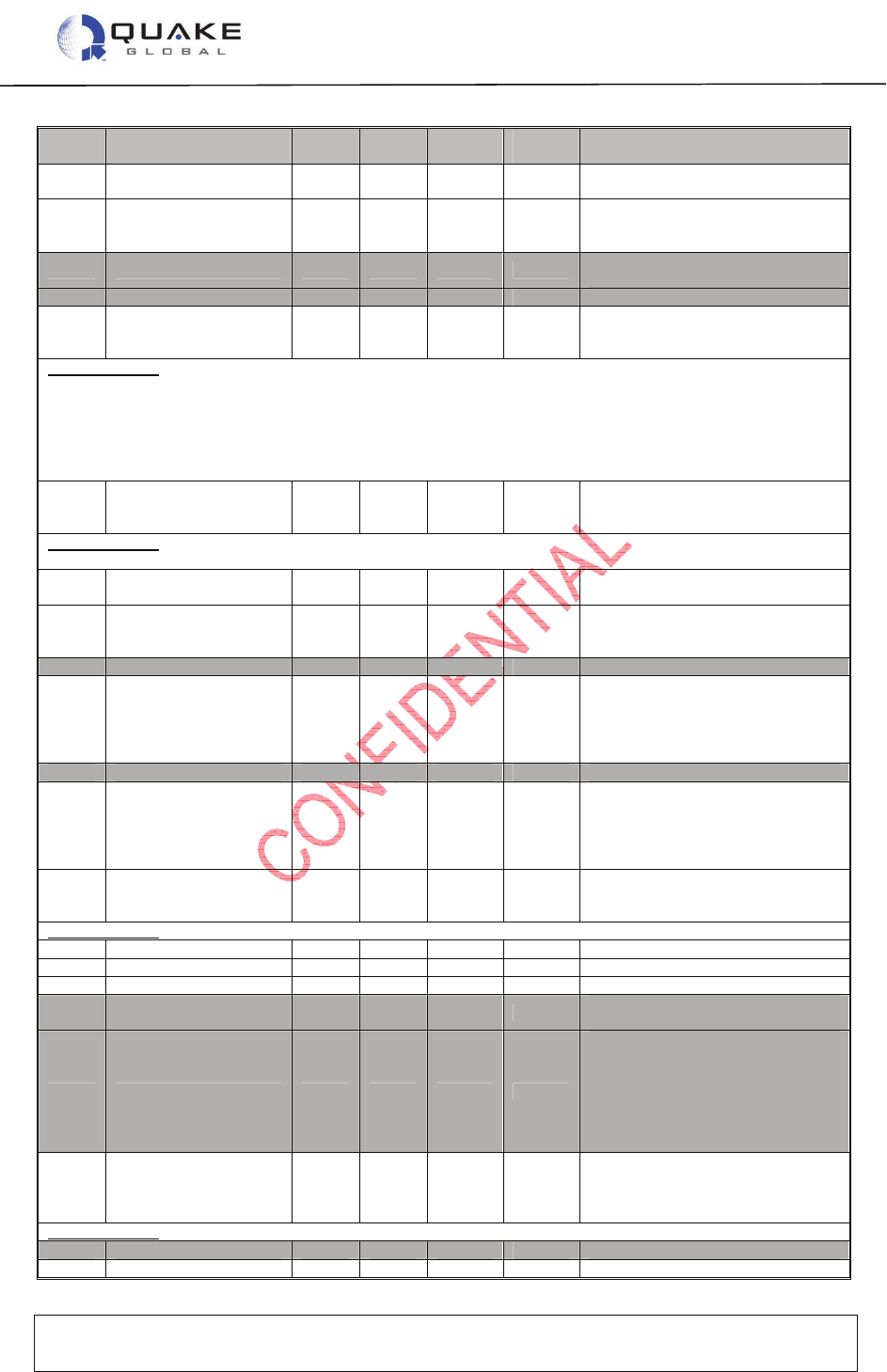
User Guide to Q4000/QPRO
Document Number 1135-4713 Rev G
THIS DOCUMENT CONTAINS CONFIDENTIAL AND PROPRIETARY INFORMATION OF QUAKE GLOBAL CORPORATION. IT MAY BE USED BY
RECIPIENT ONLY FOR THE PURPOSE FOR WHICH IT WAS TRANSMITTED AND WILL BE RETURNED UPON REQUEST OR WHEN NO LONGER NEEDED
BY RECIPIENT. DISCLOSURE TO UNAUTHORIZED THIRD PARTIES OR DUPLICATION WITHOUT THE EXPRESS WRITTEN PERMISSION OF QUAKE
GLOBAL IS PROHIBITED.
Page 150
CONFIDENTIAL
Information classified Confidential
-
Do not copy (See last page for obligations)
Num Name
Def.
Value
Min
Value
Max
Value
DTE
Access Description
0x1d lat_code --- 0 0xffffff R/W Coded geodetic latitude 0: North
Pole, 0xffffff: South Pole
0x1e lon_code --- 0 0xffffff R/W
Coded geodetic longitude 0:
Greenwich Median, increasing in
eastern direction
0x1f msg_requeue_opt 1 1 1 R/W NOT SUPPORTED - DO NOT
MODIFY
0x20 poll_response_timeout 5 2 30 R/W NOT SUPPORTED
0x21 ser_max_retries 0 0 255 R/W
Number of successive packet retries
without receiving valid ACK before
discarding packets
Additional notes: This parameter works in conjunction with parameter 0x22 (ser_pkt_timeout). It specifies the number
of attempts the modem will make to re-send a packet (to the application) that it does not receive a valid Link Level
Acknowledgement (LLACK) packet for. For example: The modem receives a modem-T message from the network
and ser_max_retries (0x21) is set to a value of 3. The modem will make its initial attempt to send this packet to the
application. If the application does not return a valid LLACK packet, the modem will wait X number of seconds
(specified by parameter 0x22) and then try to resend the packet. In this example, it would retry 3 times before
discarding the packet.
0x22 ser_pkt_timeout 3 1 30 R/W
Number of seconds modem waits for
ACK after sending last byte of a
packet before resending
Additional notes: As mentioned above, this parameter specifies the number of second the modem will wait between
retrying to send a packet to the application that it did not receive a valid LLACK packet for.
0x23 abort_response 0 0 1 R/W Abort Response 0: do nothing, 1:
send abort report
0x24 abort_report --- --- --- W
Abort Report values of ncc_id,
polled, serv_type, or_ind, and info
bytes 0-5 for abort report
0x25 ops_mode 0 0 2 R/W NOT SUPPORTED
0x26 ob_flow_cntl 3 0 3 W
Sending packets/bytes to DTE:
0: deactivated DTR stops it
1: activated RTS stops it
2: either
3: no outbound flow control
0x27 ib_flow_cntl 3 0 3 W NOT SUPPORTED
0x28 DSR_treatment 0 0 1 W
0: Not enabled
1: DSR activated if one or more
modem-Terminated messages
queued in modem (Used with
parameter 0x26)
0x29 baud_rate 4 4 10 R/W
DTE baud rate (MTS Port) 4: 4800,
5: 9600, 6: 19200, 7: 38400, 8:
57600, 9: 76800, 10: 115200
Additional notes: This parameter can be used to modify the baud rate of the MTS port.
0x2a parity_bits 0 0 2 R/W DTE parity 0: none, 1: odd, 2: even
0x2b stop_bits 1 1 2 R/W DTE stop bits
0x2c data_bits 8 7 8 R/W DTE data bits
0x2d duplex 1 0 2 R/W NOT SUPPORTED (MTS Port is full
duplex)
0x2e test_mode 0 0 4 R/W
Test Mode
0: normal operation
1: echo downlink data to DTE
2: echo uplink data to DTE
3: echo both to DTE
4: echo DTE to uplink as reservation
burst
0x2f pwr_down_mode 1 0 1 W
0: receiver power controlled by DTE
DTR signal
1: receiver power controlled by
rcvr_power parameter
Additional notes: When this parameter is set to 0 the modem will power down when DTR is deasserted.
0x30 active_set_id 1 0 1 R/W NOT SUPPORTED
0x31 serial_num --- --- --- R modem Serial Number
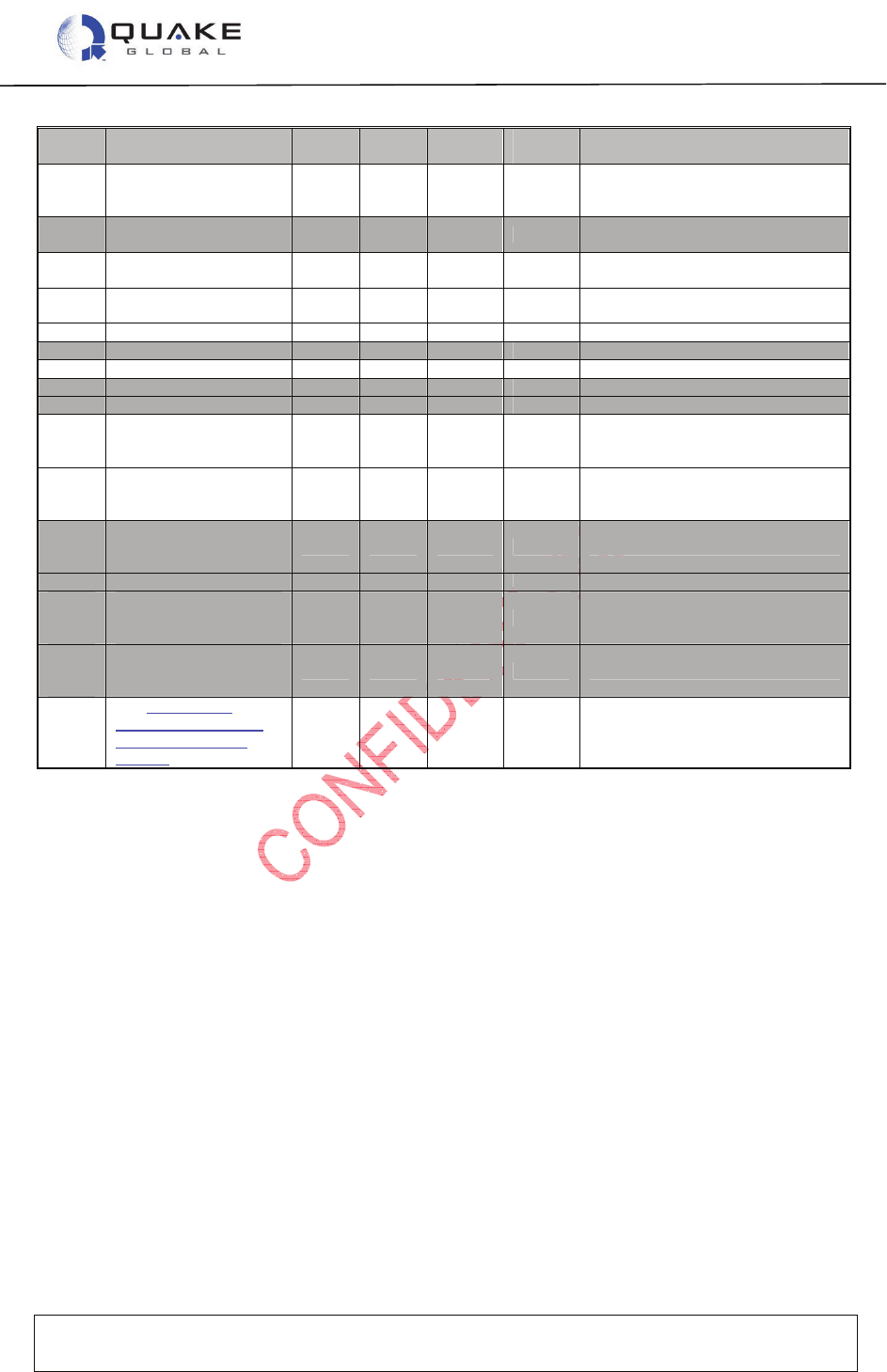
User Guide to Q4000/QPRO
Document Number 1135-4713 Rev G
THIS DOCUMENT CONTAINS CONFIDENTIAL AND PROPRIETARY INFORMATION OF QUAKE GLOBAL CORPORATION. IT MAY BE USED BY
RECIPIENT ONLY FOR THE PURPOSE FOR WHICH IT WAS TRANSMITTED AND WILL BE RETURNED UPON REQUEST OR WHEN NO LONGER NEEDED
BY RECIPIENT. DISCLOSURE TO UNAUTHORIZED THIRD PARTIES OR DUPLICATION WITHOUT THE EXPRESS WRITTEN PERMISSION OF QUAKE
GLOBAL IS PROHIBITED.
Page 151
CONFIDENTIAL
Information classified Confidential
-
Do not copy (See last page for obligations)
Num Name
Def.
Value
Min
Value
Max
Value
DTE
Access Description
0x32 sw_version --- --- --- R
Modem software version. For
example, July 5, 2005 will return
decimal 7055.
0x33 hw_version --- --- --- R NOT SUPPORTED
Numb
er Name
Def.
Value
Min
Value
Max
Value
DTE
Access Description
0x34 ser_spec_rev 'G' 'G' --- R modem Serial Interface Specification
revision supported
0x35 manu_id 4 4 4 R 4: QUAKE Global, Inc.
0x36 pos_det_supported 1 0 1 R NOT SUPPORTED
0x37 most_recent_dl --- 50 349 R Most recent downlink channel
0x38 dl_chan_list --- --- --- R NOT SUPPORTED
0x39 debug_lvl 5 0 5 R/W NOT SUPPORTED
0x3a rcvr_power 2 0 2 R/W
0. Receiver OFF
1. Listen to DL 6/16
2. Receiver continuously ON
0x3b send_pass_predict 0 1 0 W
When 1, passes Ephemeris, Satellite
plane orbital elements packets to
Application/DTE
0x3c
-
0x72
RESERVED FOR
FUTURE
ORBCOMM USE
--- --- --- --- ---
0x73 initial_pos_det 0 0 1 W NOT SUPPORTED
0x74
-
0x78
DOPPLER
POSITIONING
PARAMETERS
--- --- --- --- NOT SUPPORTED
0x79
-
0x7f
BYTE MODE
PARAMETERS --- --- --- --- NOT SUPPORTED
0x80
-
0xff
See Appendix B -
QUAKE’s ORBCOMM
configuration parms
(QCFG)
--- --- --- --- QUAKE-specific configuration
parameters
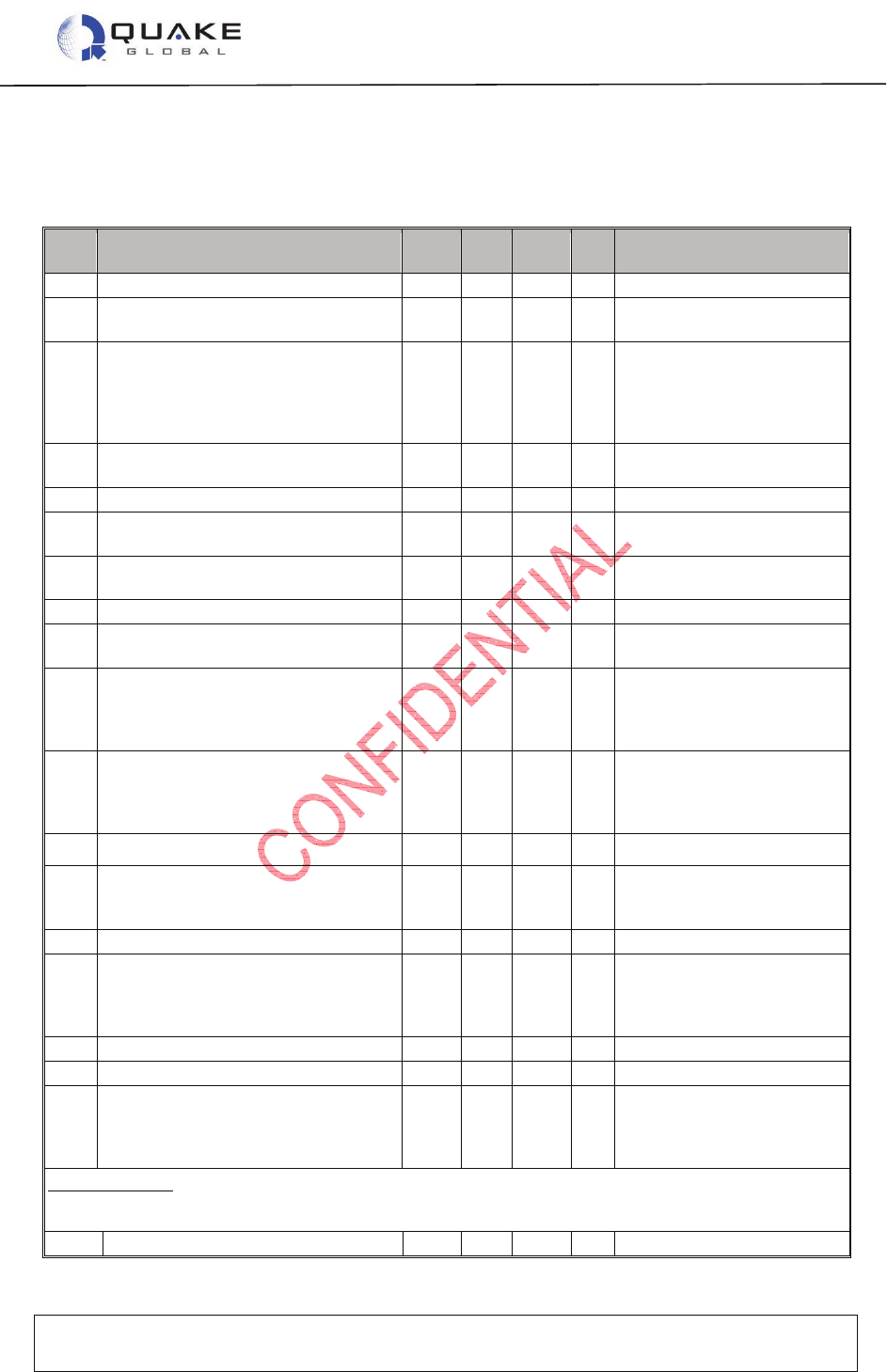
User Guide to Q4000/QPRO
Document Number 1135-4713 Rev G
THIS DOCUMENT CONTAINS CONFIDENTIAL AND PROPRIETARY INFORMATION OF QUAKE GLOBAL CORPORATION. IT MAY BE USED BY
RECIPIENT ONLY FOR THE PURPOSE FOR WHICH IT WAS TRANSMITTED AND WILL BE RETURNED UPON REQUEST OR WHEN NO LONGER NEEDED
BY RECIPIENT. DISCLOSURE TO UNAUTHORIZED THIRD PARTIES OR DUPLICATION WITHOUT THE EXPRESS WRITTEN PERMISSION OF QUAKE
GLOBAL IS PROHIBITED.
Page 152
CONFIDENTIAL
Information classified Confidential
-
Do not copy (See last page for obligations)
Appendix B - QUAKE’s ORBCOMM configuration parms (QCFG)
Table B-1: QUAKE’s ORBCOMM configuration parameters
Num
Name
Def
Val
Min
Val
Max
Val
DTE
Access
Description
0x80
QCFG_LOG_DEBUG_LEVEL 4 0 6 R/W
Logger Port log level
0x81
QCFG_GPS_LOGGING 0 0 1 R/W
GPS Task debug logging
enable
0x82
QCFG_TL_LOGGING 0 0 1 R/W
0: Not enabled
1: Enable Transport Layer
debug logging (must be set
for prms 0x83-0x88 to take
effect)
0x83
QCFG_DLEVPROC_LOG_LEVEL 0 0 5 R/W
Downlink Event Proc Task
debug level
0x84
QCFG_ULMGR_LOG_LEVEL 0 0 5 R/W
Uplink Mgr Task debug level
0x85
QCFG_SPP_LOG_LEVEL 0 0 5 R/W
Serial Pkt Proc Task debug
level
0x86
QCFG_MODEM-TMGR_LOG_LEVEL 0 0 5 R/W
modem-T Msg Mgr Task
debug level
0x87
QCFG_MODEM_LOG_LEVEL 0 0 5 R/W
TL modem Task debug level
0x88
QCFG_OSPM_LOG_LEVEL 0 0 5 R/W
OB Serial Pkt Mgr Task
debug level
0x89
QCFG_MSN_SAVE_OPTION 0 0 1 R/W
0: Save MSN data to flash on
[controlled] power down only
1: Save MSN data to flash on
any change
0x8b
QCFG_MTS_AUTO_ROAMING_ENA 0 0 1 R/W
0: Not enabled
1: Enable Auto-Roaming for
message packets received on
MTS Port
0x8c
QCFG_QLM_LOG_MASK - - - - Not supported
0x8d
QCFG_DUPL_USR_CMD_TIME_S 900 30 3600 R/W
Number of seconds for which
User Command duplicates
will be discarded
0x8e
QCFG_POWER_SAVING_MASK - - - - Not supported
0x90
QCFG_PREF_NETWORK 0 0 3 0 – GSM first
1 – ORBCOMM first
2 – GSM only
3 – ORBCOMM only
0x92
QCFG_MDMIF_PORT 3 0 3 Do not change
0x94
QCFG_DBG_UTILITY_LEVEL 5 0 5 R/W
Debug mode log level
0x95
QCFG_MTS_ARCHIVING_ENA 0 0 1 R/W
0: Not enabled
1: Enable message archiving
to flash memory of message
packets received on MTS port
Additional notes: When this parameter is enabled modem-O messages will be stored in NVM. If the
modem loses power or is put into sleep mode it will retrieve any unsent messages at boot up and return
them to the message queue.
0x98 QCFG_MODEM_APN_USER None
User login name if required
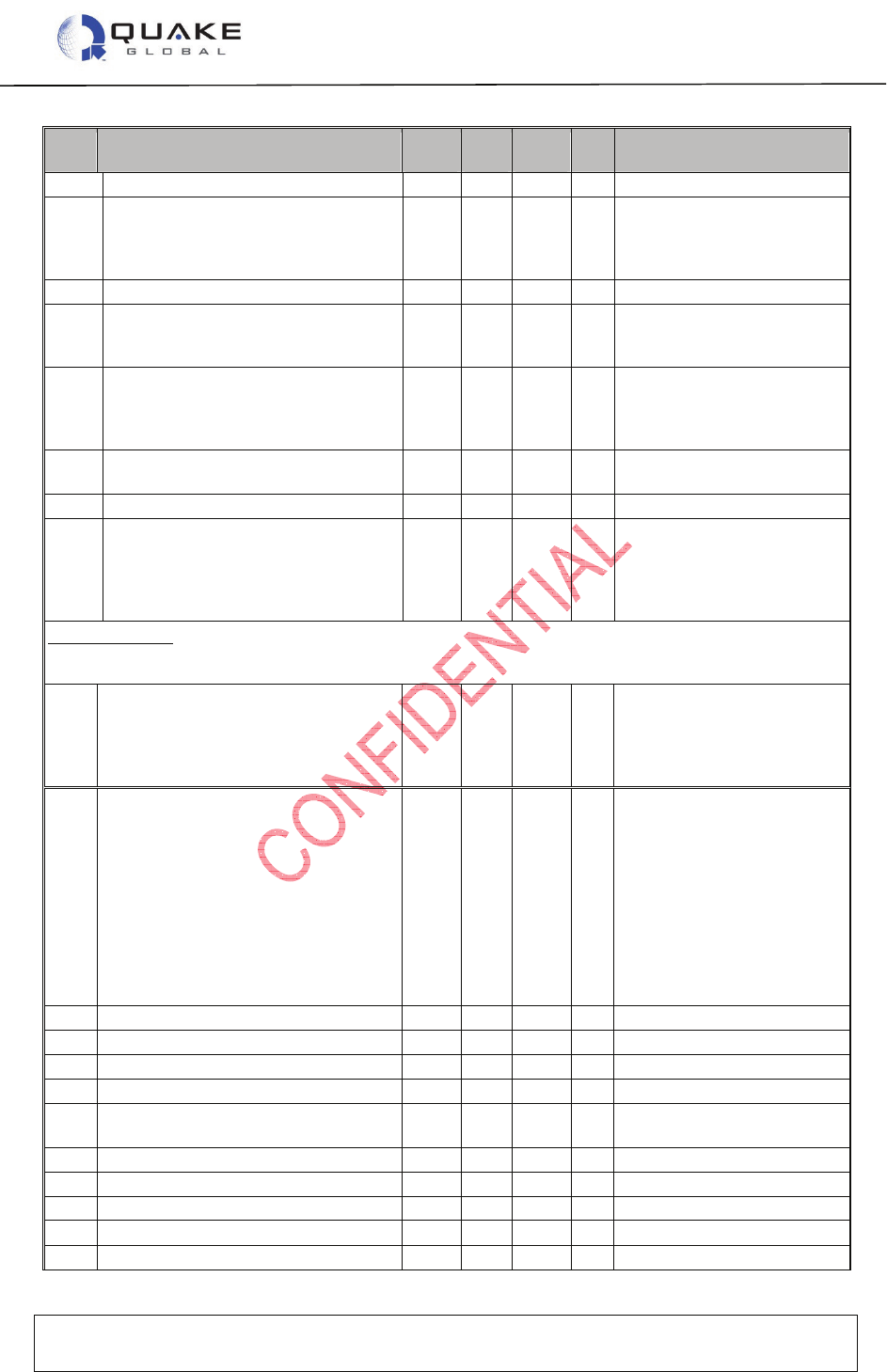
User Guide to Q4000/QPRO
Document Number 1135-4713 Rev G
THIS DOCUMENT CONTAINS CONFIDENTIAL AND PROPRIETARY INFORMATION OF QUAKE GLOBAL CORPORATION. IT MAY BE USED BY
RECIPIENT ONLY FOR THE PURPOSE FOR WHICH IT WAS TRANSMITTED AND WILL BE RETURNED UPON REQUEST OR WHEN NO LONGER NEEDED
BY RECIPIENT. DISCLOSURE TO UNAUTHORIZED THIRD PARTIES OR DUPLICATION WITHOUT THE EXPRESS WRITTEN PERMISSION OF QUAKE
GLOBAL IS PROHIBITED.
Page 153
CONFIDENTIAL
Information classified Confidential
-
Do not copy (See last page for obligations)
Num
Name
Def
Val
Min
Val
Max
Val
DTE
Access
Description
0x99 QCFG_MODEM_APN_PASS None
User password if required
0x9a QCFG_OSI_IB_ROUTE 1 0 2 R/W
Route inbound
messages/commands to:
0=Application; 1=Transport
Layer; 2=Both
0x9b QCFG_MODEM_BAND 3 0 3 Not supported
0x9d QCFG_MODEM_APN_ADDRESS Network provider name.
Default: ORBCOMM.t-
mobile.com
0x9e QCFG_MODEM_CONNECT_DUR_S 90 0 65535
If there’s no data exchange
within this timeout period
(seconds) the connection is
closed. 0 for no timeout
0x9f QCFG_EXT_MODEM_ID_INTERVAL 0 0 65535
R/W
ID Message interval (in
seconds).
0xa0 QCFG_MDMIF_BAUD_RATE - - - - Not supported
0xa1 QCFG_REQUEST_GLOBALGRAMS 0 0 1 R/W
0: Not Enabled
1: Automatically send a
Communications Command 2
(Request Globalgrams) to
satellites that come into view
Additional notes: This parameter (0xa1) must be enabled in order to receive modem-
T Globalgrams. When
set to 1 the modem will send a request to each satellite passing over that is in Globalgram mode
requesting any modem-T Globalgrams.
0xa2
QCFG_POS_FILTER_MAX_VEL 50 0 65535
R/W
Max. allowed speed in GPS
position samples (meters per
Second). GPS samples with
a larger speed will be
discarded
0xa3
QCFG_POS_FILTER_MAX_DIFF 25 0 100 R/W
Max. allowed difference in
change in distance vs. speed
× change in time between
successive GPS samples (%).
Higher values (50-75%) can
reduce average time-to-fix
(particularly in high
acceleration scenarios) but
will reduce outlier rejection
effectiveness. Set to 100 to
disable this algorithm
0xa4
QCFG_SMTP_SERVER_ADDR None
Address of SMTP mail server
0xa5
QCFG_SMTP_SERVER_PORT
25 0 65535
SMTP port (generally 25)
0xa6
QCFG_SMTP_USER None
SMTP account user name
0xa7
QCFG_SMTP_PASS None
SMTP account password
0xa8
QCFG_SMTP_TO_ADDR None
Default email address to
which to send messages
0xa9
QCFG_SMTP_SUBJ None
Default subject of the email
0xaa
QCFG_POP_SERVER_ADDR None
None
None
R/W
POP server address
0xab
QCFG_POP_SERVER_PORT 25 1 65535
R/W
POP port
0xac
QCFG_POP_USER None
None
None
R/W
Pop username
0xad
QCFG_POP_PASS None
None
None
R/W
Pop password
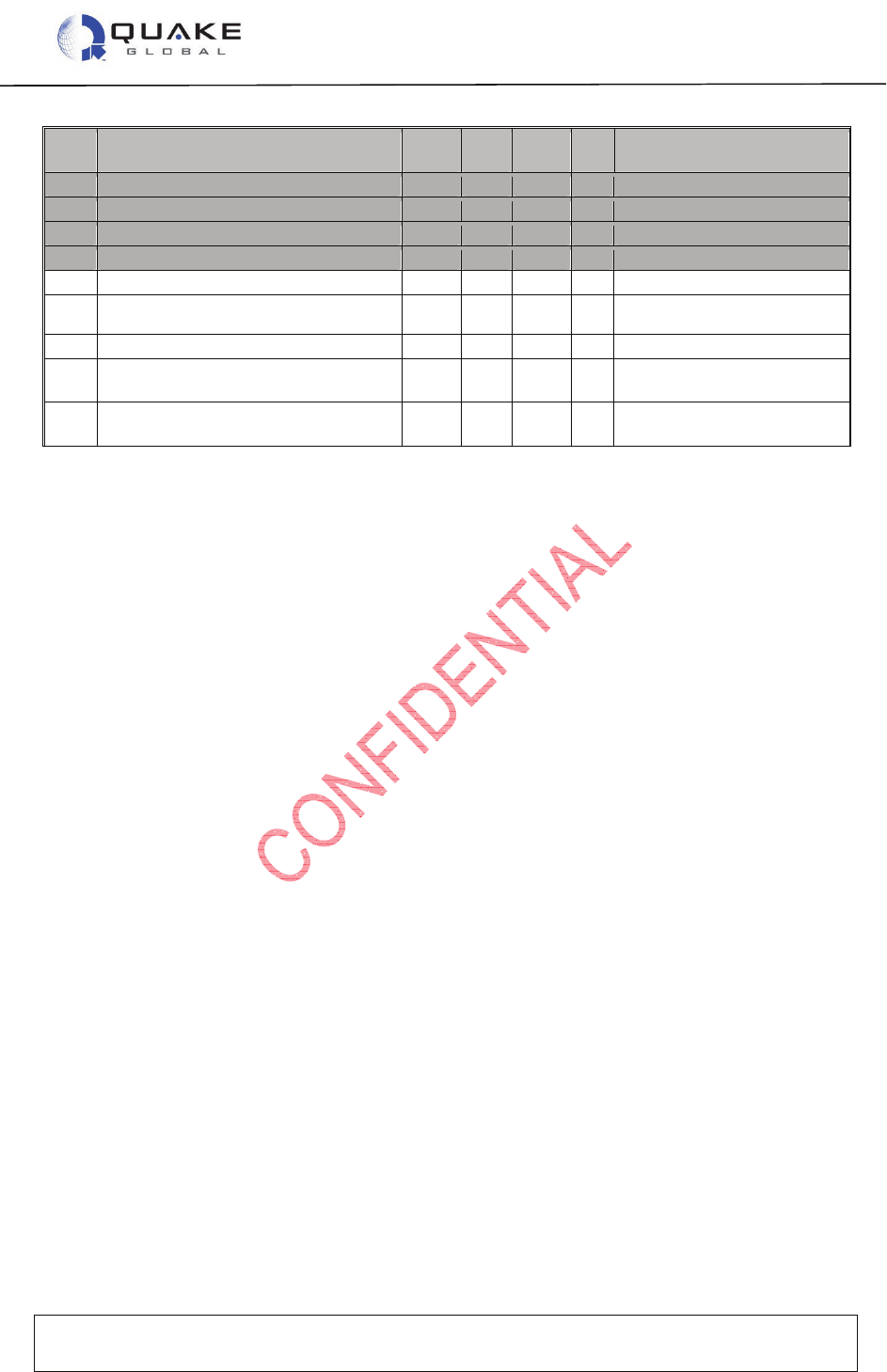
User Guide to Q4000/QPRO
Document Number 1135-4713 Rev G
THIS DOCUMENT CONTAINS CONFIDENTIAL AND PROPRIETARY INFORMATION OF QUAKE GLOBAL CORPORATION. IT MAY BE USED BY
RECIPIENT ONLY FOR THE PURPOSE FOR WHICH IT WAS TRANSMITTED AND WILL BE RETURNED UPON REQUEST OR WHEN NO LONGER NEEDED
BY RECIPIENT. DISCLOSURE TO UNAUTHORIZED THIRD PARTIES OR DUPLICATION WITHOUT THE EXPRESS WRITTEN PERMISSION OF QUAKE
GLOBAL IS PROHIBITED.
Page 154
CONFIDENTIAL
Information classified Confidential
-
Do not copy (See last page for obligations)
Num
Name
Def
Val
Min
Val
Max
Val
DTE
Access
Description
0xae
QCFG_GLSS_CHAN N/A A D R/W
GlobalStar channel
0xaf QCFG_GLSS_RETRY_COUNT N/A 3 20 R/W
GlobalStar retry count
0xb0
QCFG_GLSS_MIN_INTERVAL_S N/A 30 300 R/W
GlobalStar minimum interval
0xb1
QCFG_GLSS_MAX_INTERVAL_S N/A 60 600 R/W
GlobalStar maximum interval
0xb2
QCFG_MDMIF_IRI_PORT N/A - - R/W
Iridium port
0xb3
QCFG_AUX_BAUD_RATE 19200
1200
115200
R/W
Note that the
maximum speed
of the AUX is 57600 bps
0xb4
QCFG_MTS_BAUD_RATE 4800 1200
115200
R/W
0xb5
QCFG_POWER_DOWN_MODE 0 0 1 R/W
1=power down when DTR
goes low
0xb6
QCFG_SOFTWARE_VERSION
1.2.345
6.789
- - R/W
Version 1.2, SVN (3456),
Coverity (789)
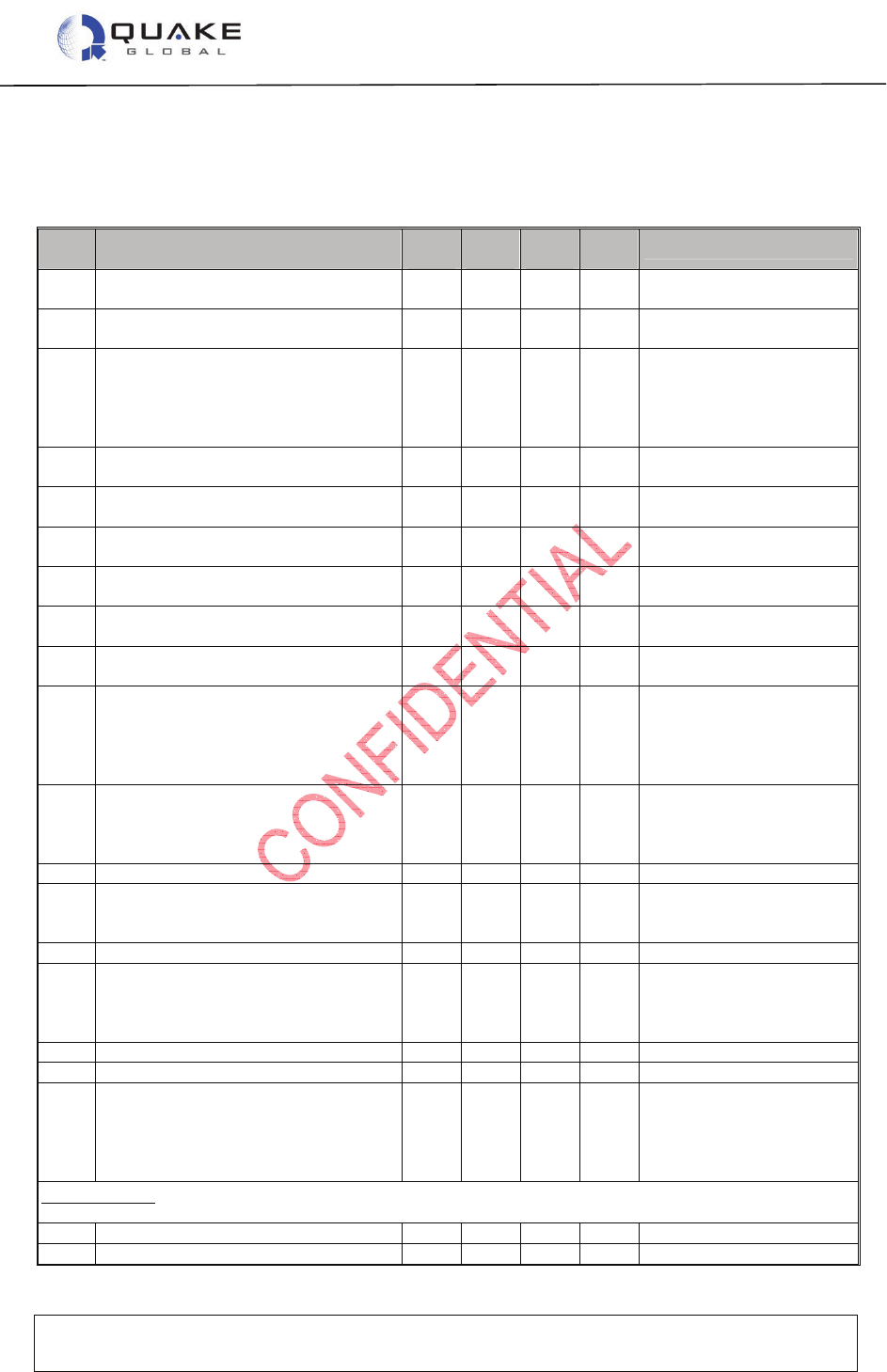
User Guide to Q4000/QPRO
Document Number 1135-4713 Rev G
THIS DOCUMENT CONTAINS CONFIDENTIAL AND PROPRIETARY INFORMATION OF QUAKE GLOBAL CORPORATION. IT MAY BE USED BY
RECIPIENT ONLY FOR THE PURPOSE FOR WHICH IT WAS TRANSMITTED AND WILL BE RETURNED UPON REQUEST OR WHEN NO LONGER NEEDED
BY RECIPIENT. DISCLOSURE TO UNAUTHORIZED THIRD PARTIES OR DUPLICATION WITHOUT THE EXPRESS WRITTEN PERMISSION OF QUAKE
GLOBAL IS PROHIBITED.
Page 155
CONFIDENTIAL
Information classified Confidential
-
Do not copy (See last page for obligations)
Appendix C - QUAKE’s Iridium & Inmarsat config parms (QCFG)
Table C-1: QUAKE’s Iridium and Inmarsat configuration parameters
Num
Name
Def
Val
Min
Val
Max
Val
DTE
Access
Description
0x80 QCFG_LOG_DEBUG_LEVEL 4 0 6 Level of logging messages
output
0x81 QCFG_GPS_LOGGING 0 0 1 R/W GPS Task debug logging
enable
0x82 QCFG_TL_LOGGING 0 0 1 R/W 0: Not enabled
1: Enable Transport Layer
debug logging (must be set
for prms 0x83-0x88 to take
effect)
0x83 QCFG_DLEVPROC_LOG_LEVEL 0 0 5 R/W Downlink Event Proc Task
debug level
0x84 QCFG_ULMGR_LOG_LEVEL 0 0 5 R/W Uplink Mgr Task debug
level
0x85 QCFG_SPP_LOG_LEVEL 0 0 5 R/W Serial Pkt Proc Task debug
level
0x86 QCFG_MODEM-TMGR_LOG_LEVEL 0 0 5 R/W modem-T Msg Mgr Task
debug level
0x87 QCFG_MODEM_LOG_LEVEL 0 0 5 R/W TL modem Task debug
level
0x88 QCFG_OSPM_LOG_LEVEL 0 0 5 R/W OB Serial Pkt Mgr Task
debug level
0x89 QCFG_MSN_SAVE_OPTION 0 0 1 R/W 0: Save MSN data to flash
on [controlled] power down
only
1: Save MSN data to flash
on any change
0x8b QCFG_MTS_AUTO_ROAMING_ENA 0 0 1 R/W 0: Not enabled
1: Enable Auto-
Roaming for
message packets received
on MTS Port
0x8c QCFG_QLM_LOG_MASK - - - - Not supported
0x8d QCFG_DUPL_USR_CMD_TIME_S 900 30 3600 R/W Number of Seconds for
which User Command
duplicates will be discarded
0x8e QCFG_POWER_SAVING_MASK - - - - Not supported
0x90 QCFG_PREF_NETWORK 0 0 3 0 – GSM first
1 – Sat first
2 – GSM only
3 – Sat only
0x92 QCFG_MDMIF_PORT 3 0 4
0x94 QCFG_DBG_UTILITY_LEVEL 5 0 5 R/W Debug Mode log level
0x95 QCFG_MTS_ARCHIVING_ENA 0 0 1 R/W 0: Not enabled
1: Enable Message
Archiving to flash memory
of msg packets received on
the MTS Port
Additional notes: When this parameter is enabled, modem-O msgs will be stored in NVM. If the modem loses
power or is put into sleep mode it will retrieve any unsent msgs at boot up and return them to the msg queue.
0x98 QCFG_MODEM_APN_USER None
User login name if required
0x99 QCFG_MODEM_APN_PASS None
User password if required
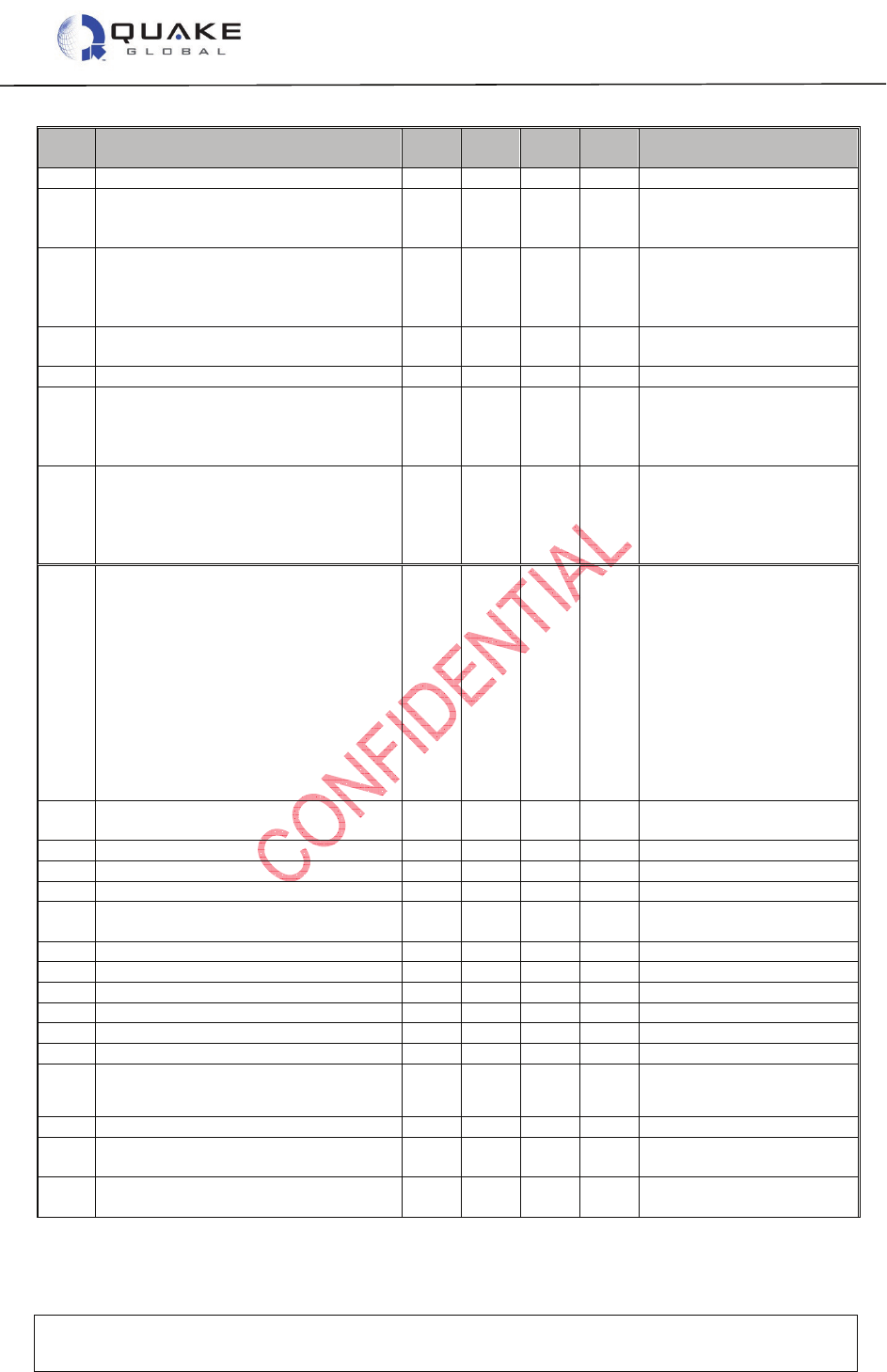
User Guide to Q4000/QPRO
Document Number 1135-4713 Rev G
THIS DOCUMENT CONTAINS CONFIDENTIAL AND PROPRIETARY INFORMATION OF QUAKE GLOBAL CORPORATION. IT MAY BE USED BY
RECIPIENT ONLY FOR THE PURPOSE FOR WHICH IT WAS TRANSMITTED AND WILL BE RETURNED UPON REQUEST OR WHEN NO LONGER NEEDED
BY RECIPIENT. DISCLOSURE TO UNAUTHORIZED THIRD PARTIES OR DUPLICATION WITHOUT THE EXPRESS WRITTEN PERMISSION OF QUAKE
GLOBAL IS PROHIBITED.
Page 156
CONFIDENTIAL
Information classified Confidential
-
Do not copy (See last page for obligations)
Num
Name
Def
Val
Min
Val
Max
Val
DTE
Access
Description
0x9b QCFG_MODEM_BAND 3 0 3 Not supported
0x9d QCFG_MODEM_APN_ADDRESS Network provider name
Default: ORBCOMM.t-
mobile.com
0x9e QCFG_MODEM_CONNECT_DUR_S 90 0 65535
If there’s no data exchange
within this timeout period
(seconds) the connection is
closed. 0 for no timeout
0x9f QCFG_EXT_MODEM_ID_INTERVAL 0 0 65535
R/W ID Message interval (in
seconds).
0xa0 QCFG_MDMIF_BAUD_RATE - - - - Not supported
0xa1 QCFG_REQUEST_GLOBALGRAMS 0 0 1 R/W This is not a valid
parameter for non-
ORBCOMM modems. It is
ignored by them.
0xa2 QCFG_POS_FILTER_MAX_VEL 50 0 65535
R/W Max. allowed speed in GPS
position samples (meters
per Second). GPS
samples with a larger
speed will be discarded
0xa3 QCFG_POS_FILTER_MAX_DIFF 25 0 100 R/W Max. allowed difference in
change in distance vs.
speed × change in time
between successive GPS
samples (%). Higher
values (50-75%) can
reduce average time-to-fix
(particularly in high
acceleration scenarios) but
will reduce outlier rejection
effectiveness. S
et to 100 to
disable this algorithm
0xa4 QCFG_SMTP_SERVER_ADDR None
Address of SMTP Mail
Server
0xa5 QCFG_SMTP_SERVER_PORT
25 0 65535
SMTP Port (generally 25)
0xa6 QCFG_SMTP_USER None
SMTP Account User Name
0xa7 QCFG_SMTP_PASS None
SMTP Account Password
0xa8 QCFG_SMTP_TO_ADDR None
Default email address to
send messages to
0xa9 QCFG_SMTP_SUBJ None
Default subject of the email
0xaa QCFG_POP_SERVER_ADDR None
None
None
R/W POP server address
0xab QCFG_POP_SERVER_PORT 25 1 65535
R/W POP port
0xac QCFG_POP_USER None
None
None
R/W Pop username
0xad QCFG_POP_PASS None
None
None
R/W Pop password
0xb2 QCFG_MDMIF_IRI_PORT 4 - - R/W Iridium port
0xb3 QCFG_AUX_BAUD_RATE 19200
1200
115200
R/W
Note that the
maximum
speed of the AUX port is
57600 bps
0xb4 QCFG_MTS_BAUD_RATE 4800 1200
115200
R/W
0xb5 QCFG_POWER_DOWN_MODE 0 0 1 R/W 1=power down when DTR
goes low
0xb6 QCFG_SOFTWARE_VERSION
1.2.34
56.789
- - R/W Version 1.2, SVN (3456),
Coverity (789)
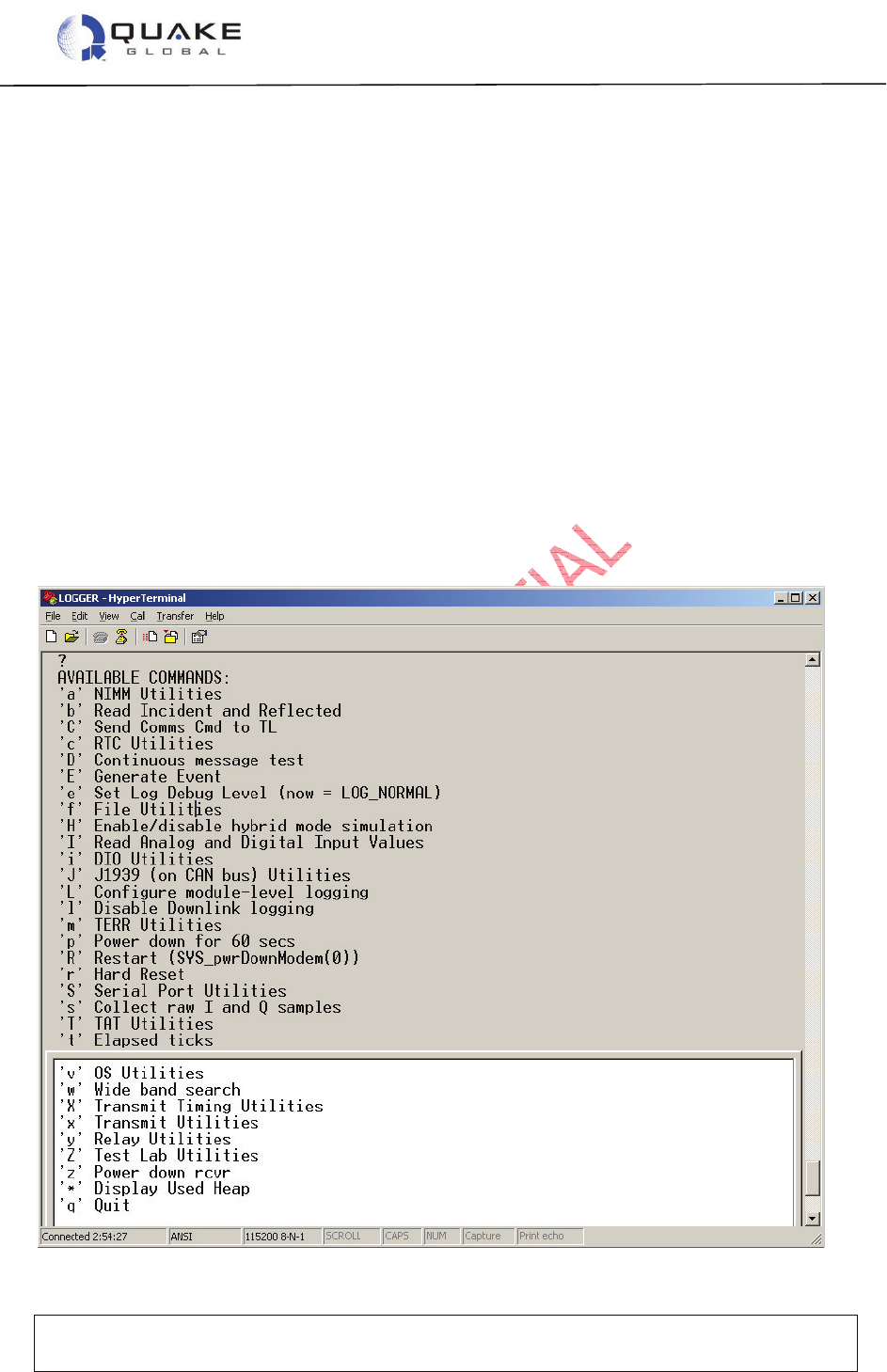
User Guide to Q4000/QPRO
Document Number 1135-4713 Rev G
THIS DOCUMENT CONTAINS CONFIDENTIAL AND PROPRIETARY INFORMATION OF QUAKE GLOBAL CORPORATION. IT MAY BE USED BY
RECIPIENT ONLY FOR THE PURPOSE FOR WHICH IT WAS TRANSMITTED AND WILL BE RETURNED UPON REQUEST OR WHEN NO LONGER NEEDED
BY RECIPIENT. DISCLOSURE TO UNAUTHORIZED THIRD PARTIES OR DUPLICATION WITHOUT THE EXPRESS WRITTEN PERMISSION OF QUAKE
GLOBAL IS PROHIBITED.
Page 157
CONFIDENTIAL
Information classified Confidential
-
Do not copy (See last page for obligations)
Appendix D - Debug and utility menus
QUAKE Global provides a large group of debug and utility menus which are accessible via the
Logger port. These menus allow the user to send and receive messages and email, view
operational performance, conduct serial tests and many more functions. Some of the menus
require a password and are accessible to QUAKE personnel only. The menus are accessible
from the Logger port using the following settings:
Baud rate: 115200 bps
Data bits: 8
Parity: None
Stop bits: 1
Flow control: None
Two different commands can be used to enter the menus, either ‘d’ (debug) or ‘U’ (utility). Each
command will display a listing of debug or utility menus respectively. Each menu can be entered
by typing the corresponding letter code in the list. The list of letter codes for either menu can be
displayed by typing ‘?’. For example, ‘d’ ‘?’ gives the list of letter codes (commands) for all the
debug menus listed under ‘d’.
Figure E-1: Debug menus available from ‘d’ ‘?’
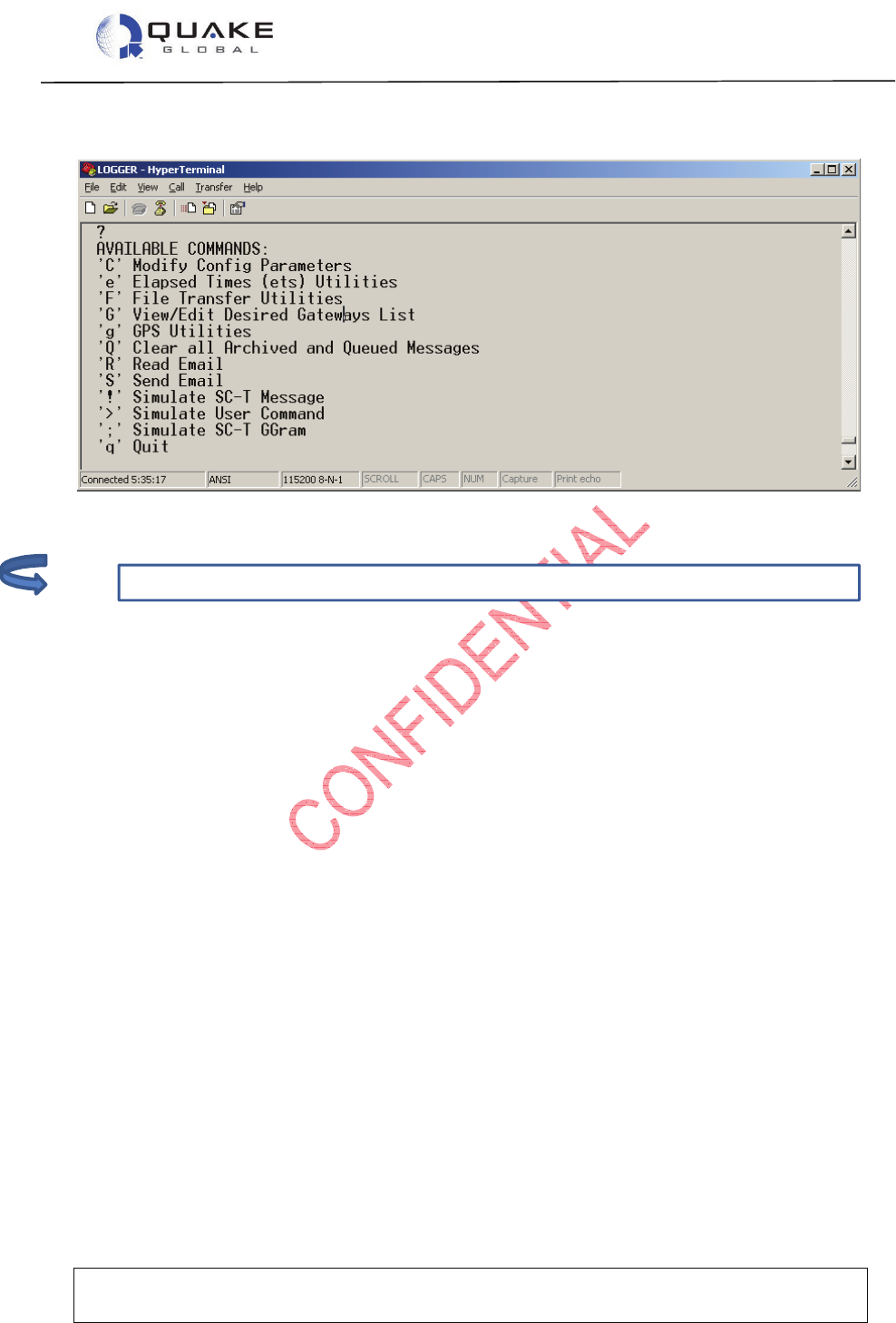
User Guide to Q4000/QPRO
Document Number 1135-4713 Rev G
THIS DOCUMENT CONTAINS CONFIDENTIAL AND PROPRIETARY INFORMATION OF QUAKE GLOBAL CORPORATION. IT MAY BE USED BY
RECIPIENT ONLY FOR THE PURPOSE FOR WHICH IT WAS TRANSMITTED AND WILL BE RETURNED UPON REQUEST OR WHEN NO LONGER NEEDED
BY RECIPIENT. DISCLOSURE TO UNAUTHORIZED THIRD PARTIES OR DUPLICATION WITHOUT THE EXPRESS WRITTEN PERMISSION OF QUAKE
GLOBAL IS PROHIBITED.
Page 158
CONFIDENTIAL
Information classified Confidential
-
Do not copy (See last page for obligations)
See section
7.2.1
for examp
les of using the menu commands on the Logger port.
Additional utility commands are available by typing ‘U’ ‘?’:
Figure E- 2, Debug menus available from 'U' '?'
Note:
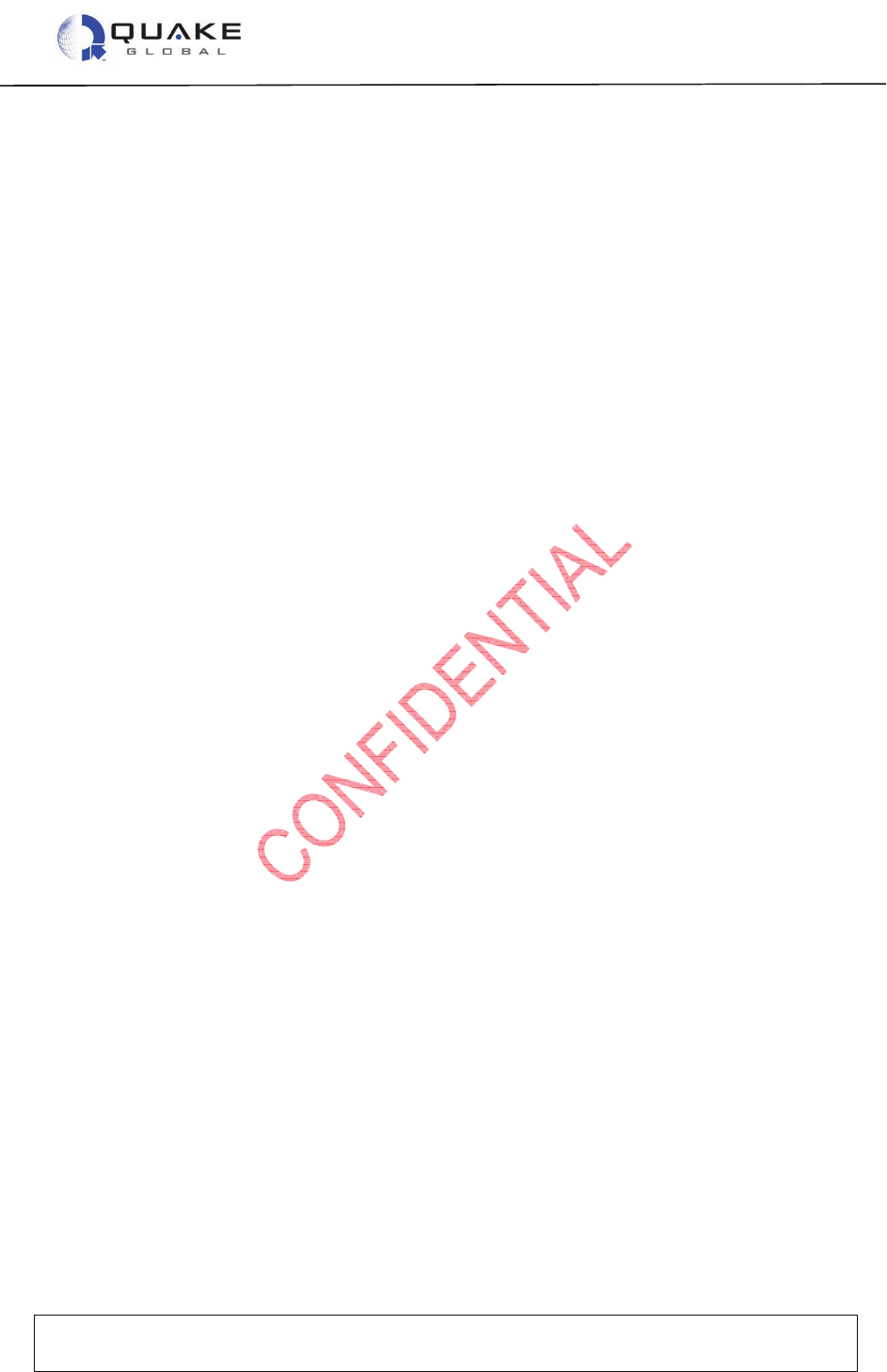
User Guide to Q4000/QPRO
Document Number 1135-4713 Rev G
THIS DOCUMENT CONTAINS CONFIDENTIAL AND PROPRIETARY INFORMATION OF QUAKE GLOBAL CORPORATION. IT MAY BE USED BY
RECIPIENT ONLY FOR THE PURPOSE FOR WHICH IT WAS TRANSMITTED AND WILL BE RETURNED UPON REQUEST OR WHEN NO LONGER NEEDED
BY RECIPIENT. DISCLOSURE TO UNAUTHORIZED THIRD PARTIES OR DUPLICATION WITHOUT THE EXPRESS WRITTEN PERMISSION OF QUAKE
GLOBAL IS PROHIBITED.
Page 159
CONFIDENTIAL
Information classified Confidential
-
Do not copy (See last page for obligations)
Appendix E - Software file naming convention
The name of a code file follows the format:
<Product Label><File Type>-<Hardware Features Label>-aa.bb.cccc.dd-<File Identifier>.bin
where:
• Product Label is defined in
• Table E-1
• File Type is defined in Table E-2
• Hardware Features Label is defined in
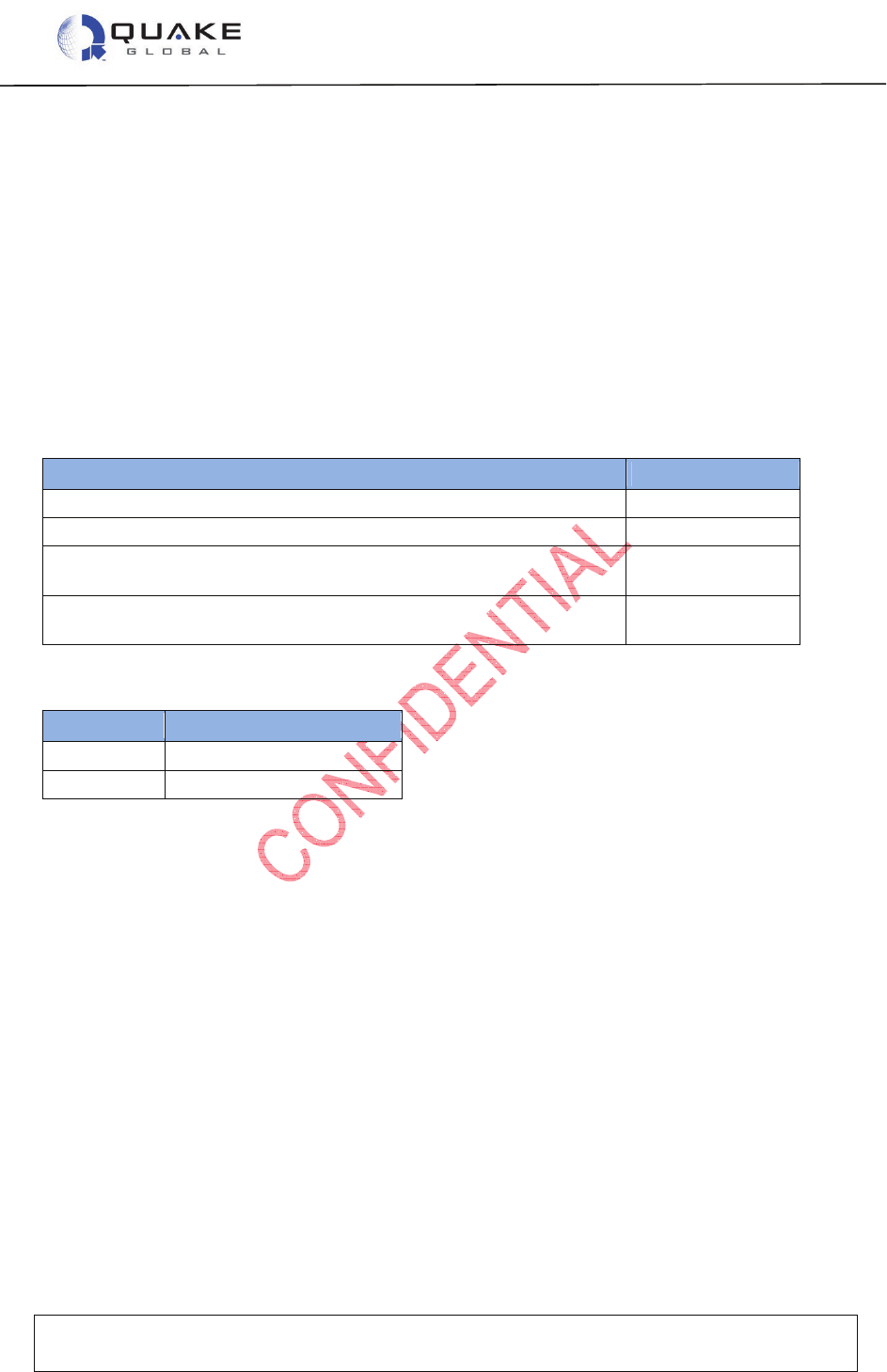
User Guide to Q4000/QPRO
Document Number 1135-4713 Rev G
THIS DOCUMENT CONTAINS CONFIDENTIAL AND PROPRIETARY INFORMATION OF QUAKE GLOBAL CORPORATION. IT MAY BE USED BY
RECIPIENT ONLY FOR THE PURPOSE FOR WHICH IT WAS TRANSMITTED AND WILL BE RETURNED UPON REQUEST OR WHEN NO LONGER NEEDED
BY RECIPIENT. DISCLOSURE TO UNAUTHORIZED THIRD PARTIES OR DUPLICATION WITHOUT THE EXPRESS WRITTEN PERMISSION OF QUAKE
GLOBAL IS PROHIBITED.
Page 160
CONFIDENTIAL
Information classified Confidential
-
Do not copy (See last page for obligations)
• Table E-3
• aa is the Major version
• bb is the Minor version
• cccc is the Subversion build
• dd is the Coverity Checker ID
• File Identifier is defined in Table E-4
Example:
Q4Kf-HGT-2.20.5434.10452-ENC.bin
Table E-1: File naming – Product label
Product Label
Description
Q4K Q4000
Q1K Q1000
QPRO
(for applications and foundation code produced before 4/9/2011)
QPRO-3G
Q4KI
(for applications produced before 4/9/2011)
Iridium application
Table E-2: File naming – File type
File Type Description
f a Foundation image
a an application image
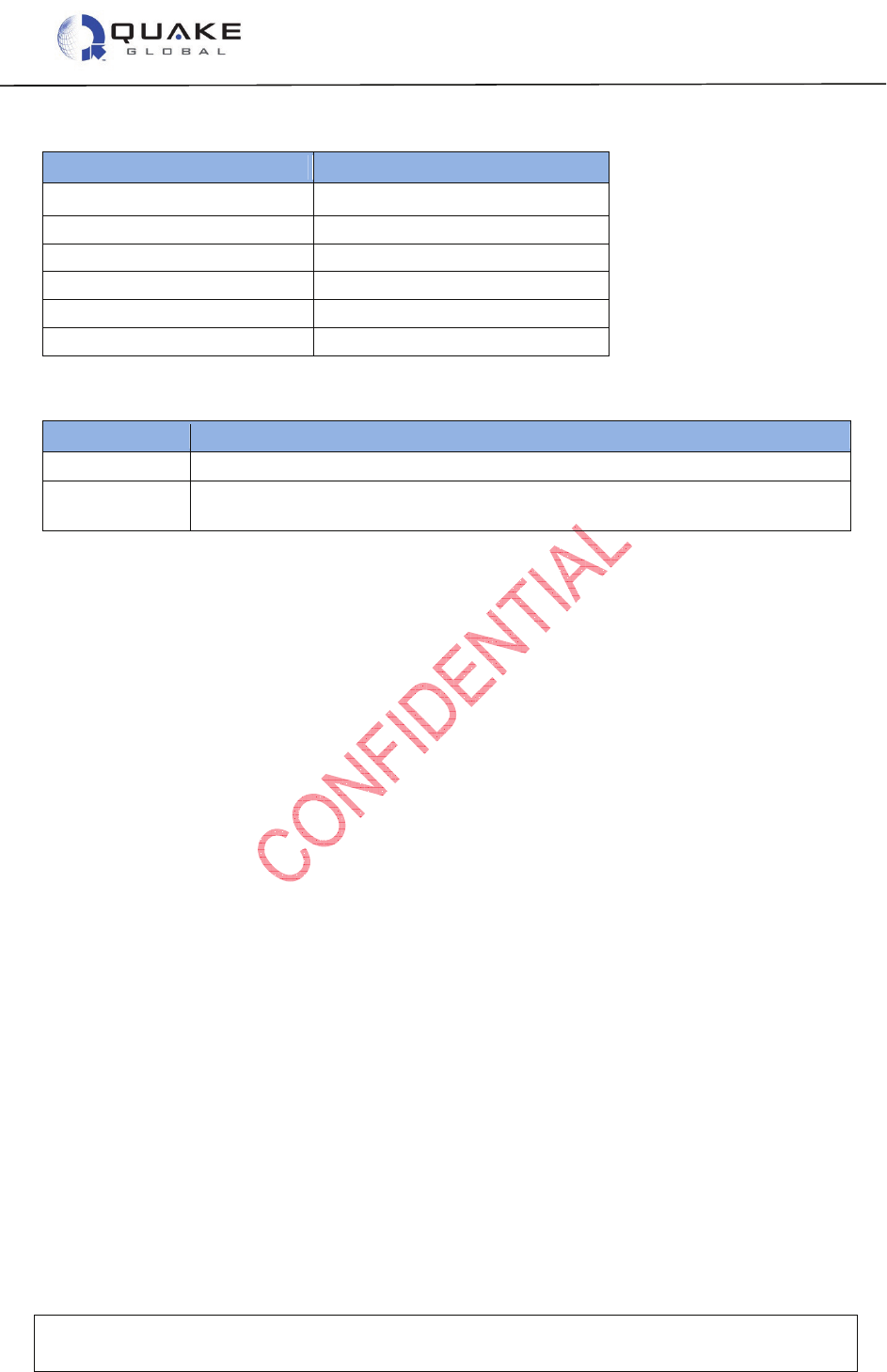
User Guide to Q4000/QPRO
Document Number 1135-4713 Rev G
THIS DOCUMENT CONTAINS CONFIDENTIAL AND PROPRIETARY INFORMATION OF QUAKE GLOBAL CORPORATION. IT MAY BE USED BY
RECIPIENT ONLY FOR THE PURPOSE FOR WHICH IT WAS TRANSMITTED AND WILL BE RETURNED UPON REQUEST OR WHEN NO LONGER NEEDED
BY RECIPIENT. DISCLOSURE TO UNAUTHORIZED THIRD PARTIES OR DUPLICATION WITHOUT THE EXPRESS WRITTEN PERMISSION OF QUAKE
GLOBAL IS PROHIBITED.
Page 161
CONFIDENTIAL
Information classified Confidential
-
Do not copy (See last page for obligations)
Table E-3: File naming – Hardware features label
Hardware Features Label Description
ONN
ORBCOMM
GGT Globalstar, GSM, Trimble
HGT ORBCOMM, GSM, Trimble
IGT Iridium, GSM, Trimble
H3T ORBCOMM, 3G, Trimble
JGT InmarSat, GSM, Trimble
Table E-4: File naming – File identifier
File Type Description
ENC an encrypted, loadable image
<App name> the name of the application. If the app is customer-specific
image the value
will be the customer name.
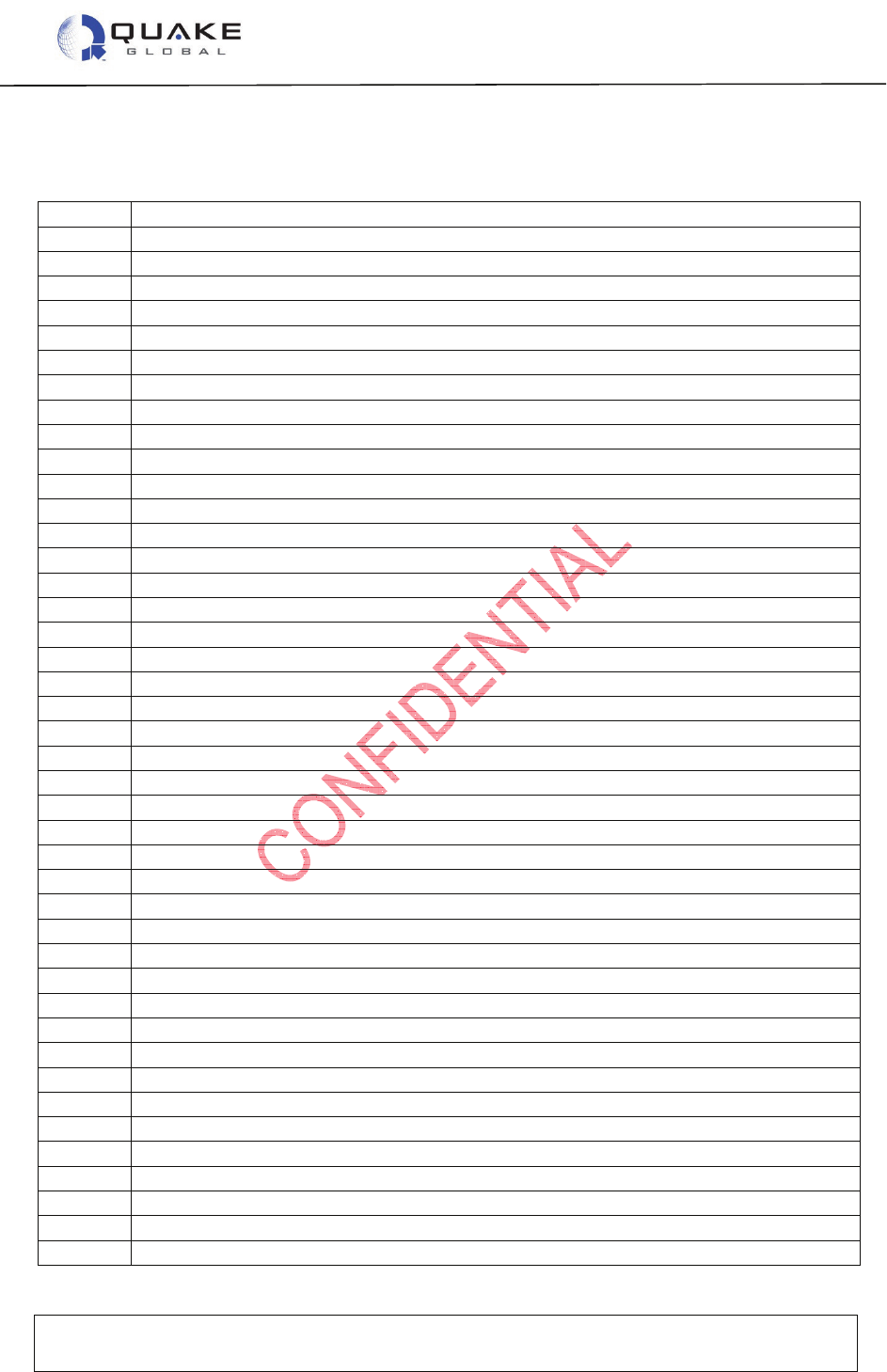
User Guide to Q4000/QPRO
Document Number 1135-4713 Rev G
THIS DOCUMENT CONTAINS CONFIDENTIAL AND PROPRIETARY INFORMATION OF QUAKE GLOBAL CORPORATION. IT MAY BE USED BY
RECIPIENT ONLY FOR THE PURPOSE FOR WHICH IT WAS TRANSMITTED AND WILL BE RETURNED UPON REQUEST OR WHEN NO LONGER NEEDED
BY RECIPIENT. DISCLOSURE TO UNAUTHORIZED THIRD PARTIES OR DUPLICATION WITHOUT THE EXPRESS WRITTEN PERMISSION OF QUAKE
GLOBAL IS PROHIBITED.
Page 162
CONFIDENTIAL
Information classified Confidential
-
Do not copy (See last page for obligations)
Appendix F - Glossary of terms
ADC Analog to Digital Converter
API Application Programming Interface
BPS Bits per Second
CAN Controller Area Network
CD Carrier Detect Signal
CR Carriage Return
DIO Digital Input/Output
DTE Data Terminal Equipment
DTR Data Terminal Ready signal
EDA Event Driven Architecture
FFS Flash File System
FTP File Transport Protocol
GPRS General Packet Radio Service
GPS Global Positioning System
GSM Global System for Mobile communications
GUI Graphical User Interface
ICD Interface Control Drawing
IDE Integrated Development Environment
IMS International Mobile Subscriber identify
LEO Low Earth Orbit
LF Line Feed
LSB Least Significant Bit
MHz Megahertz
MID Message Identification
MO Mobile Originated (Iridium network)
MT Mobile Terminated (Iridium network)
MTS Main Transport Socket
NCC Network Control Center
NVM Non-Volatile Memory
O/R Originator/Recipient
OSI ORBCOMM Serial Interface
OTA Over the Air
PGN Parameter Group Number
POP Post Office Protocol
QCFG QUAKE Configuration Parameters
QCP QUAKE Configuration Protocol
QCT QUAKE Configuration Tool
QFFS QUAKE Flash File System
QMM QUAKE Memory Manager
QRTOS
QUAKE Real-time Operating System
RPM Revolutions Per Minute
RTC Real-time Clock
RTOS Real-time Operating System
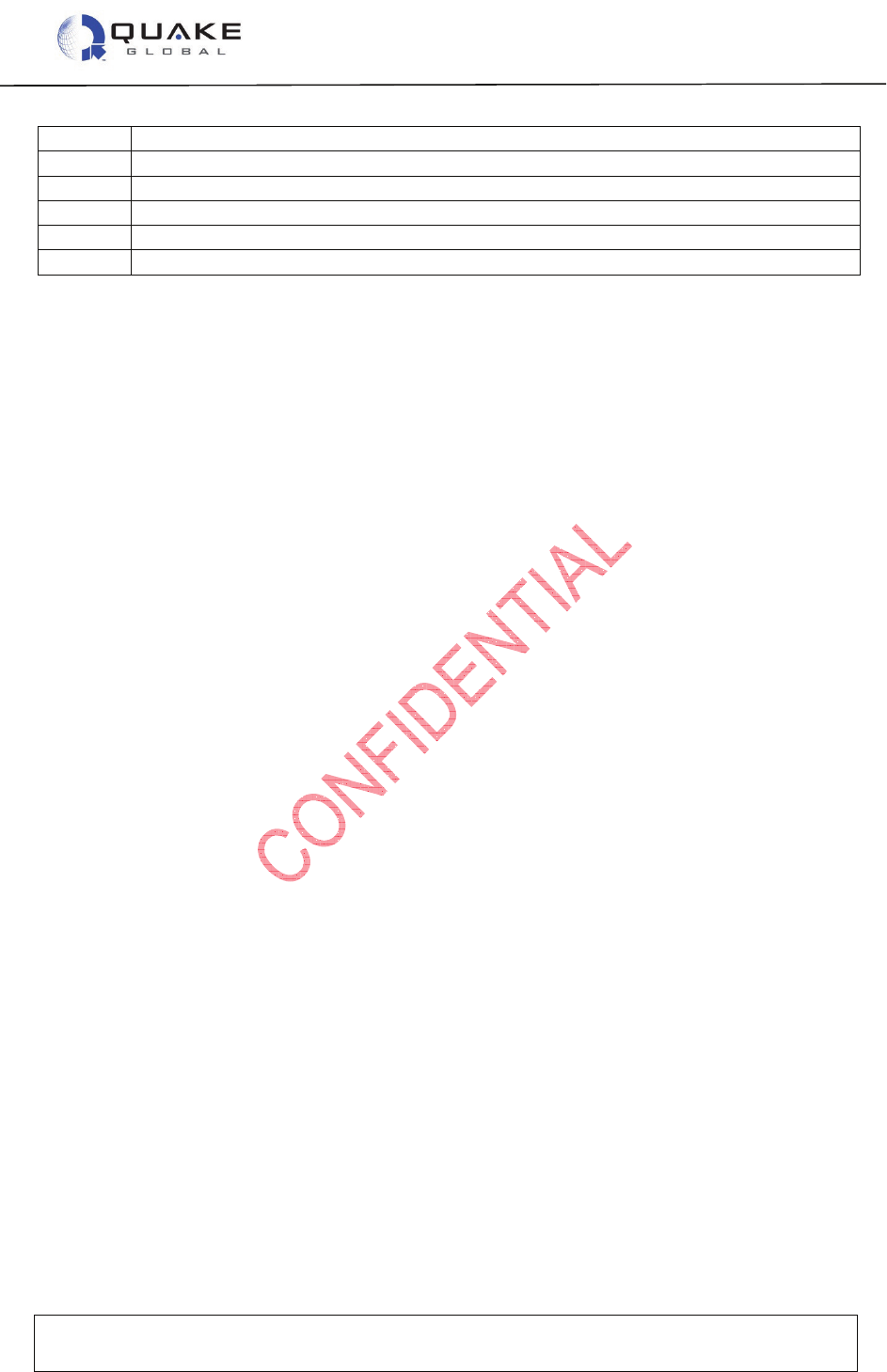
User Guide to Q4000/QPRO
Document Number 1135-4713 Rev G
THIS DOCUMENT CONTAINS CONFIDENTIAL AND PROPRIETARY INFORMATION OF QUAKE GLOBAL CORPORATION. IT MAY BE USED BY
RECIPIENT ONLY FOR THE PURPOSE FOR WHICH IT WAS TRANSMITTED AND WILL BE RETURNED UPON REQUEST OR WHEN NO LONGER NEEDED
BY RECIPIENT. DISCLOSURE TO UNAUTHORIZED THIRD PARTIES OR DUPLICATION WITHOUT THE EXPRESS WRITTEN PERMISSION OF QUAKE
GLOBAL IS PROHIBITED.
Page 163
CONFIDENTIAL
Information classified Confidential
-
Do not copy (See last page for obligations)
SAE Society of Automotive Engineers
SBD Short Burst Data
SMTP Simple Mail Transfer Protocol
UART Universal Asynchronous Receiver/Transmitter
VSWR Voltage Standing Wave Ratio
VHF Very High Frequency
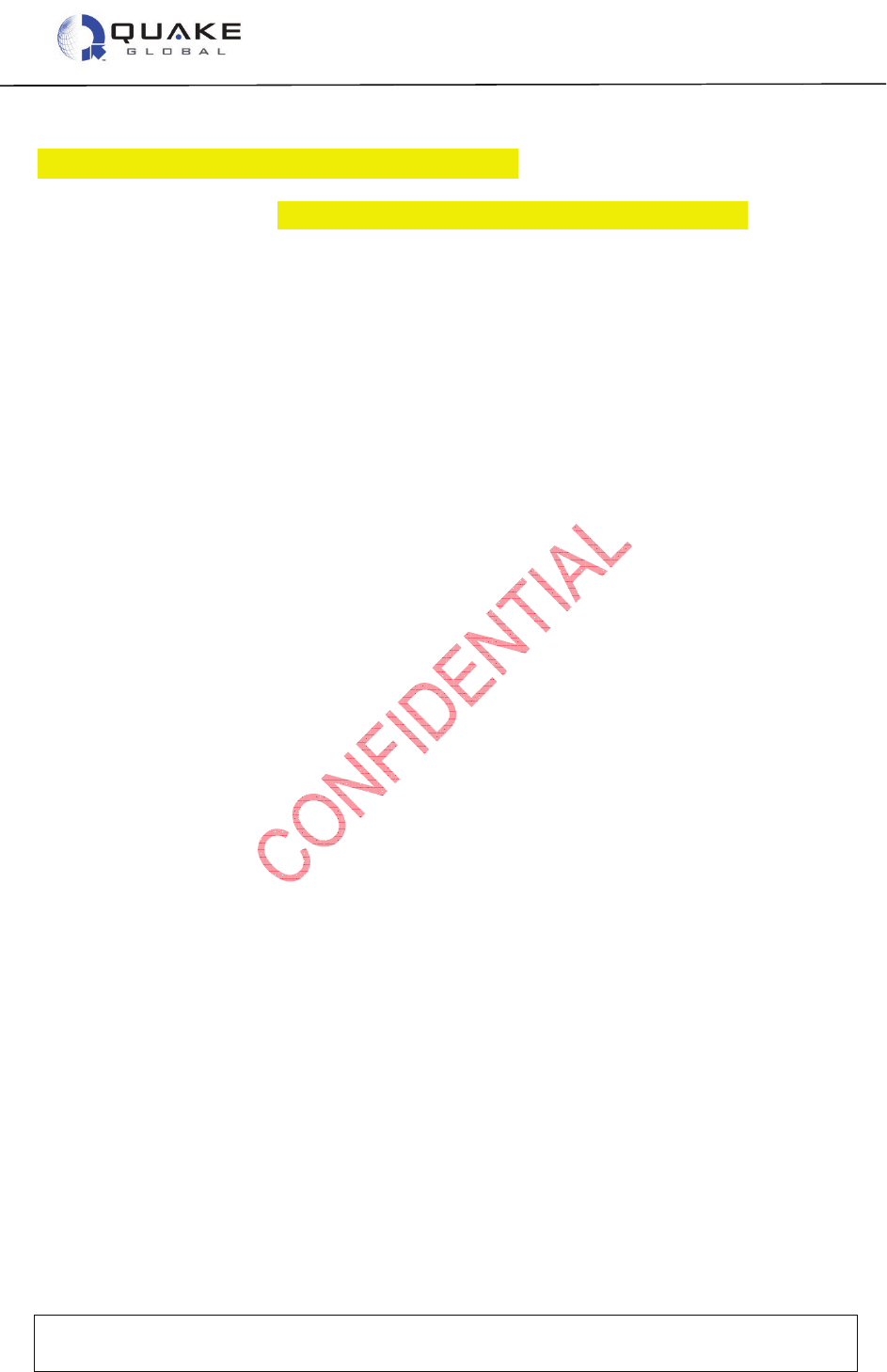
User Guide to Q4000/QPRO
Document Number 1135-4713 Rev G
THIS DOCUMENT CONTAINS CONFIDENTIAL AND PROPRIETARY INFORMATION OF QUAKE GLOBAL CORPORATION. IT MAY BE USED BY
RECIPIENT ONLY FOR THE PURPOSE FOR WHICH IT WAS TRANSMITTED AND WILL BE RETURNED UPON REQUEST OR WHEN NO LONGER NEEDED
BY RECIPIENT. DISCLOSURE TO UNAUTHORIZED THIRD PARTIES OR DUPLICATION WITHOUT THE EXPRESS WRITTEN PERMISSION OF QUAKE
GLOBAL IS PROHIBITED.
Page 164
CONFIDENTIAL
Information classified Confidential
-
Do not copy (See last page for obligations)
16 Active Graveyard (where to place?)
16.1 DTR handling (used to be in 9.6 Working with Turnkey)
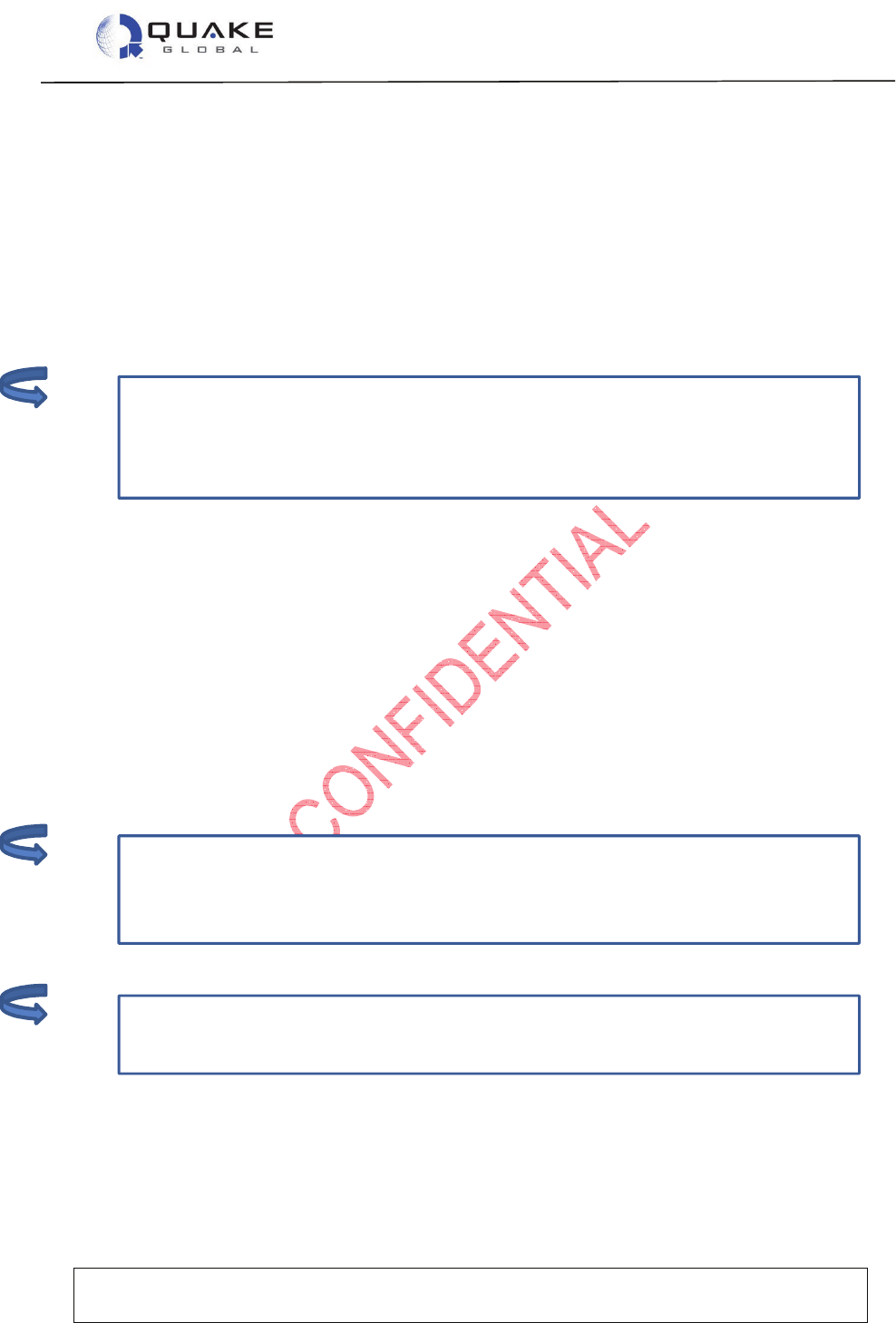
User Guide to Q4000/QPRO
Document Number 1135-4713 Rev G
THIS DOCUMENT CONTAINS CONFIDENTIAL AND PROPRIETARY INFORMATION OF QUAKE GLOBAL CORPORATION. IT MAY BE USED BY
RECIPIENT ONLY FOR THE PURPOSE FOR WHICH IT WAS TRANSMITTED AND WILL BE RETURNED UPON REQUEST OR WHEN NO LONGER NEEDED
BY RECIPIENT. DISCLOSURE TO UNAUTHORIZED THIRD PARTIES OR DUPLICATION WITHOUT THE EXPRESS WRITTEN PERMISSION OF QUAKE
GLOBAL IS PROHIBITED.
Page 165
CONFIDENTIAL
Information classified Confidential
-
Do not copy (See last page for obligations)
For CAN usage:
•at high load and 30 PGNs, CPU usage is 26%
•at moderate load and 30 PGNs, CPU usage is 16%
•adding the reception of 10 PGNs per second increases the load by 2-3%.
The Logger port, if used by the customer to receive data, should not be run above
19200. It could drop bytes otherwise. The Logger port should be used for debugging
purposes only.
The AUX port
•maximum speed is 57600 bps
•may not be available on certain configurations of the Q4000/QPRO. The
Q4000/QPRO with Iridium or Inmarsat, for example, does not have the AUX port
available.
17 Load conditions
The Q4000/QPRO can perform the following actions simultaneously
:
• send messages on the GSM/GPRS port at 115200 bps continuously
• send messages via satellite network continuously
• use MTS port at 115200 bits per second (bps)
• use AUX port at 115200 bps
• continuously obtain GPS fixes
• run Logger port at debug level 6
• access CAN bus messages by providing the desired PGN.
• As long as filtering is done in foundation, a fully loaded CAN bus at 250 Kbps is
supported. Raw CAN bus filtering cannot be done at the application level
because the input queue can quickly overflow if the ORBCOMM module is
running (see Note below).
• continuously run OSI protocol at 115200
• perform OTA upgrades
• CPU load can reach 85-90% during these loading conditions.
Note:
Note:
Note:
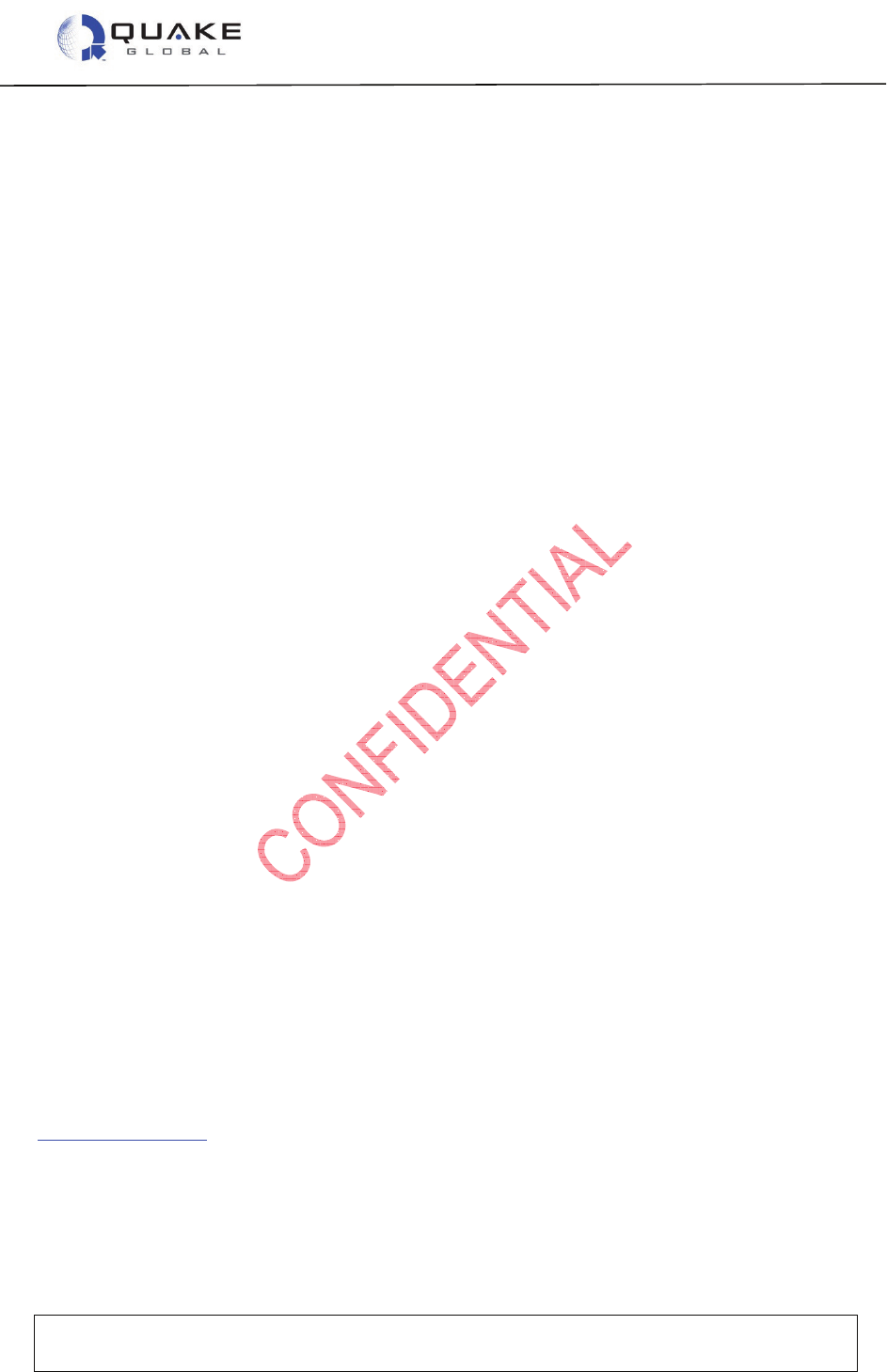
User Guide to Q4000/QPRO
Document Number 1135-4713 Rev G
THIS DOCUMENT CONTAINS CONFIDENTIAL AND PROPRIETARY INFORMATION OF QUAKE GLOBAL CORPORATION. IT MAY BE USED BY
RECIPIENT ONLY FOR THE PURPOSE FOR WHICH IT WAS TRANSMITTED AND WILL BE RETURNED UPON REQUEST OR WHEN NO LONGER NEEDED
BY RECIPIENT. DISCLOSURE TO UNAUTHORIZED THIRD PARTIES OR DUPLICATION WITHOUT THE EXPRESS WRITTEN PERMISSION OF QUAKE
GLOBAL IS PROHIBITED.
Page 166
CONFIDENTIAL
Information classified Confidential
-
Do not copy (See last page for obligations)
Confidentiality obligations
This document contains sensitive information and is classified “CONFIDENTIAL”.
Its distribution is subject to the recipient’s signature of a Non-Disclosure Agreement (NDA).
At all times you should comply with the following security rules (Refer to the NDA for detailed obligations):
This document may not be altered in any way that removes or obscures the Confidentiality notices.
Keep this document locked away.
Additional copies can be provided on a “need to know basis”, please contact your QUAKE account manager.
Please read carefully:
Information in this document is provided solely in connection with Quake Global, Inc. (“QUAKE”) products.
QUAKE™ reserves the right to make changes, corrections, modifications or improvements to this document
and the products and services described herein at any time, without notice.
All QUAKE products are sold pursuant to QUAKE’s terms and conditions of sale. Purchasers are solely
responsible for the choice, selection and use of QUAKE products and services described herein, and
QUAKE assumes no liability whatsoever relating to the choice, selection or use of QUAKE products and
services described herein. No license, express or implied, by estoppel or otherwise, to any intellectual
property rights is granted under this document. If any part of this document refers to any third party products
or services, it shall not be deemed a license grant by QUAKE for the use of such third party products or
services, or any intellectual property contained therein or considered as a warranty covering the use in any
manner whatsoever of such third party products or services or any intellectual property contained therein.
UNLESS OTHERWISE SET FORTH IN QUAKE’S TERMS AND CONDITIONS OF SALE, QUAKE
DImodemLAIMS ANY EXPRESS OR IMPLIED WARRANTY WITH RESPECT TO THE USE AND/OR
SALE OF QUAKE PRODUCTS INCLUDING, WITHOUT LIMITATION, IMPLIED WARRANTIES OF
MERCHANTABILITY, FITNESS FOR A PARTICULAR PURPOSE (AND THEIR EQUIVALENTS UNDER
THE LAWS OF ANY JURISDICTION), OR INFRINGEMENT OF ANY PATENT, COPYRIGHT OR OTHER
INTELLECTUAL PROPERTY RIGHT. UNLESS EXPRESSLY APPROVED IN WRITING BY AN
AUTHORIZED QUAKE REPRESENTATIVE, QUAKE PRODUCTS ARE NOT RECOMMENDED,
AUTHORIZED OR WARRANTED FOR USE IN MILITARY, AIRCRAFT, SPACE, LIFE SAVING, OR LIFE
SUSTAINING APPLICATIONS, NOR IN PRODUCTS OR SYSTEMS WHERE FAILURE OR
MALFUNCTION MAY RESULT IN PERSONAL INJURY, DEATH OR SEVERE PROPERTY OR
ENVIRONMENTAL DAMAGE.
Resale of QUAKE products with provisions different from the statements and/or technical features set forth
in this document shall immediately void any warranty granted by QUAKE for the QUAKE product or service
described herein and shall not create or extend in any manner whatsoever, any liability to QUAKE.
QUAKE™ and the QUAKE logo are trademarks or registered trademarks of QUAKE Global. Information in
this document supersedes and replaces all information previously supplied.
© 2011 QUAKE GLOBAL, INC. - All rights reserved
www.quakeglobal.com